Beachcombers ID Hotline
Text us a photo of that thing you found on the beach!
Number: (850) 895-1519

Lettuce Bryozoan
Sent in by Alison G, Aug. 27, 2021.
This is a bryozoan, sometimes called a 'moss animal.' Bryozoans are small aquatic invertebrates that live attached to substrate and use a crown of tentacles to facilitate filter feeding. The species here is Thalamoporella gothica, a lettuce bryozoan, due to their form being similar to a collection of brittle, crinkled leaves. The lettuce bryozoan is not one organism, but a colony of tiny bryozoans (zooids) each roughly the size of a grain of sand. Interesting fact: while it is common to find lettuce bryozoan on our gulf coast, you hardly ever see them on the east coast of Florida!

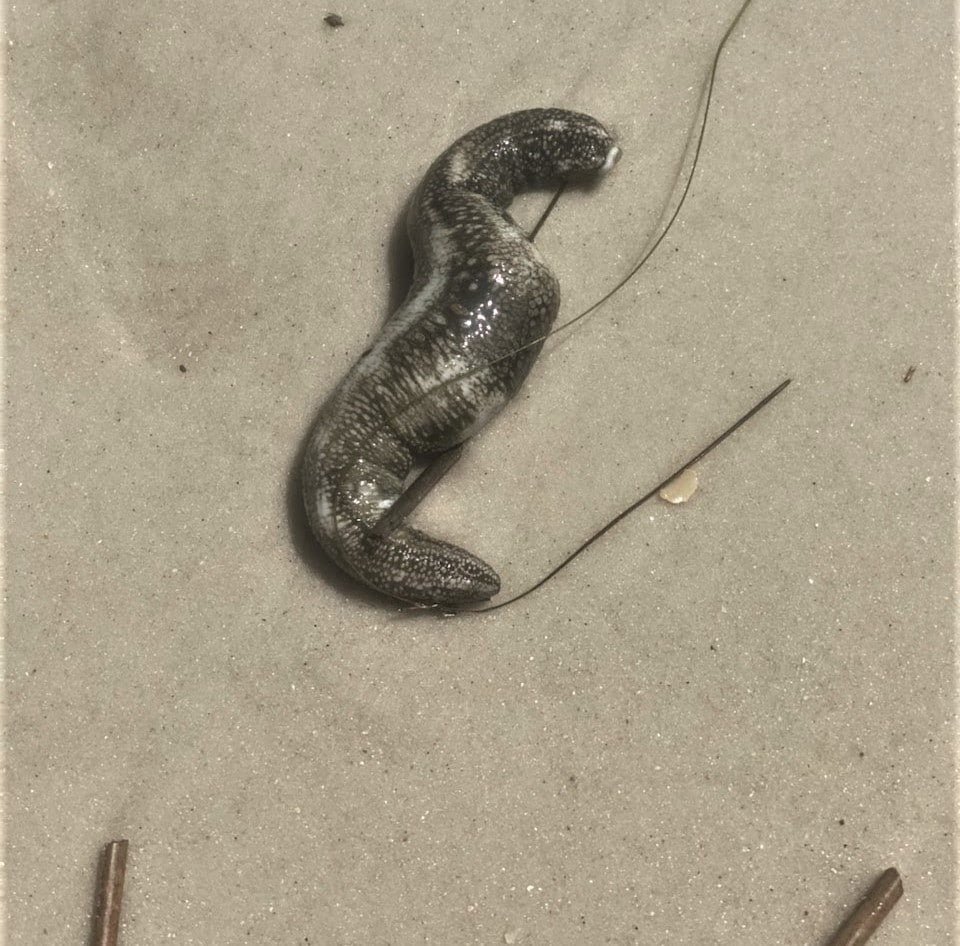
Striped Sea Cucumber
Sent in by Anonymous, Aug. 20, 2021.
This is Thyonella gemmata, a striped sea cucumber. Striped cucumbers are boomerang-shaped due to spending their lives in shallow-water burrows. They usually retain this form even after being beached; this one must have been heavily surf-tossed before you found it. Their diet consists of algae, small aquatic invertebrates, and floating waste particles. Sea cucumbers fall under the phylum Echinodermata along with starfish, brittle stars, sea urchins, and sea lilies. Members of Echinodermata are related in that they have radial symmetry, spiny skin, and rows of tube feet to help them move around and hunt. Interesting fact: many sea cucumbers, including T. gemmata, will eviscerate when stressed, meaning they will expel most of their internal organs. This is done in order to distract and/or disgust a potential predator. The organs grow back later in just a few short weeks!

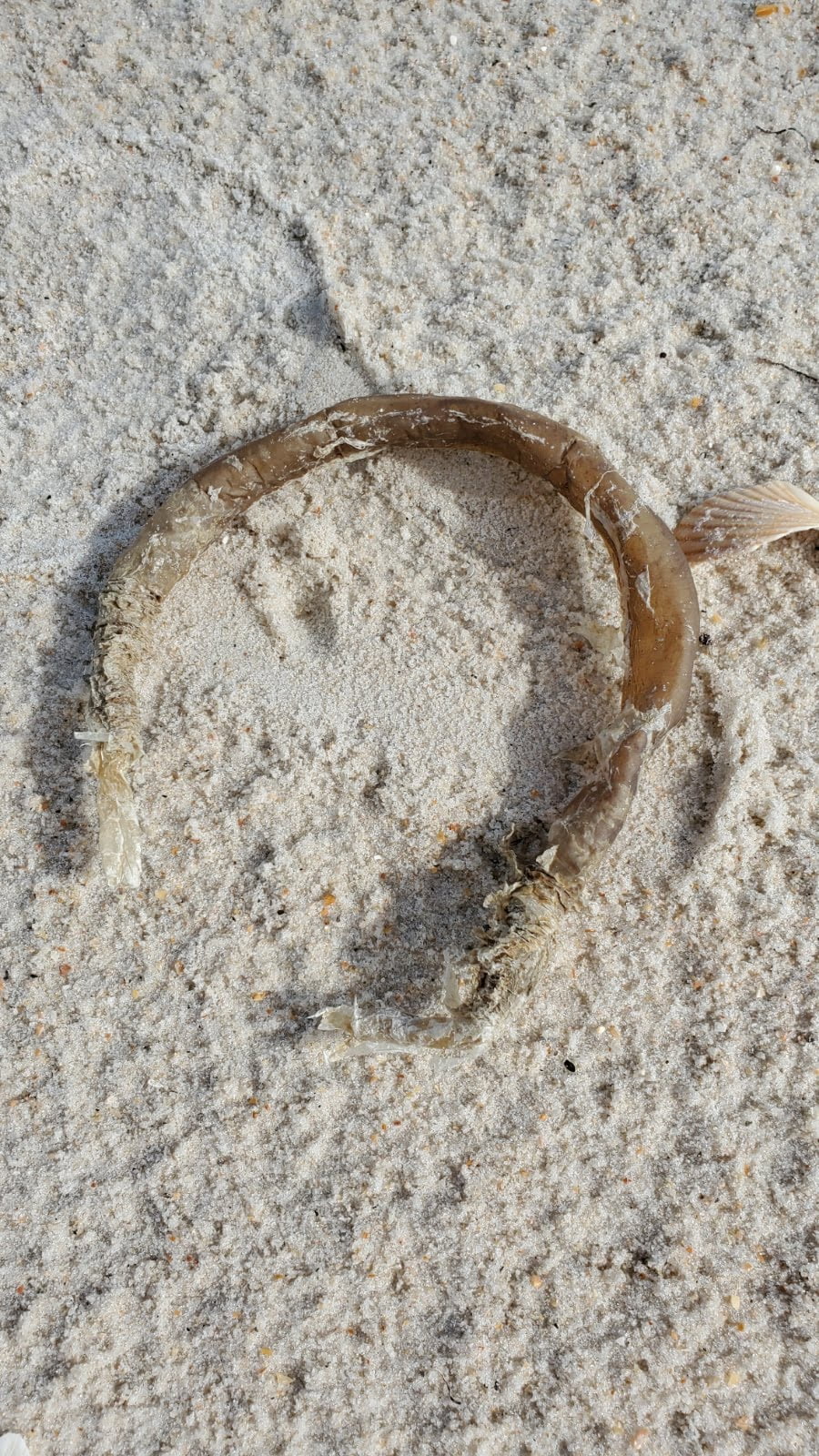
Parchment Worm Tube
Sent in by Sylence C., Aug. 28, 2021.
What you have there is a tube made by a parchment worm (Chaetopterus sp.). Parchment worms fall under the scientific family Siboglinidae, which includes approximately 100 species of worms that build tubes to serve as their homes. A parchment worm's tube is made out of sand and mud mixed with the creature's own mucous. The worm spends its entire life within its tube, which itself remains buried in muddy sediment. Tube worms are filter-feeders, meaning they use a built in "strainer" to separate and consume microscopic organisms (ex. plankton, bacteria) from seawater they take in. Parchment worms construct their tubes into a U shape to aid in filter feeding. Seawater is pulled in on one end, filtered, then pumped out the other end. Parchment worm tubes are often found on the beach after heavy storms yank them out of the sea floor. Interesting fact: seahorses often use the tubes of live parchment worms as an anchor to the seafloor. While anchored, they hunt small, bottom-dwelling creatures such as sea roaches and mysids.

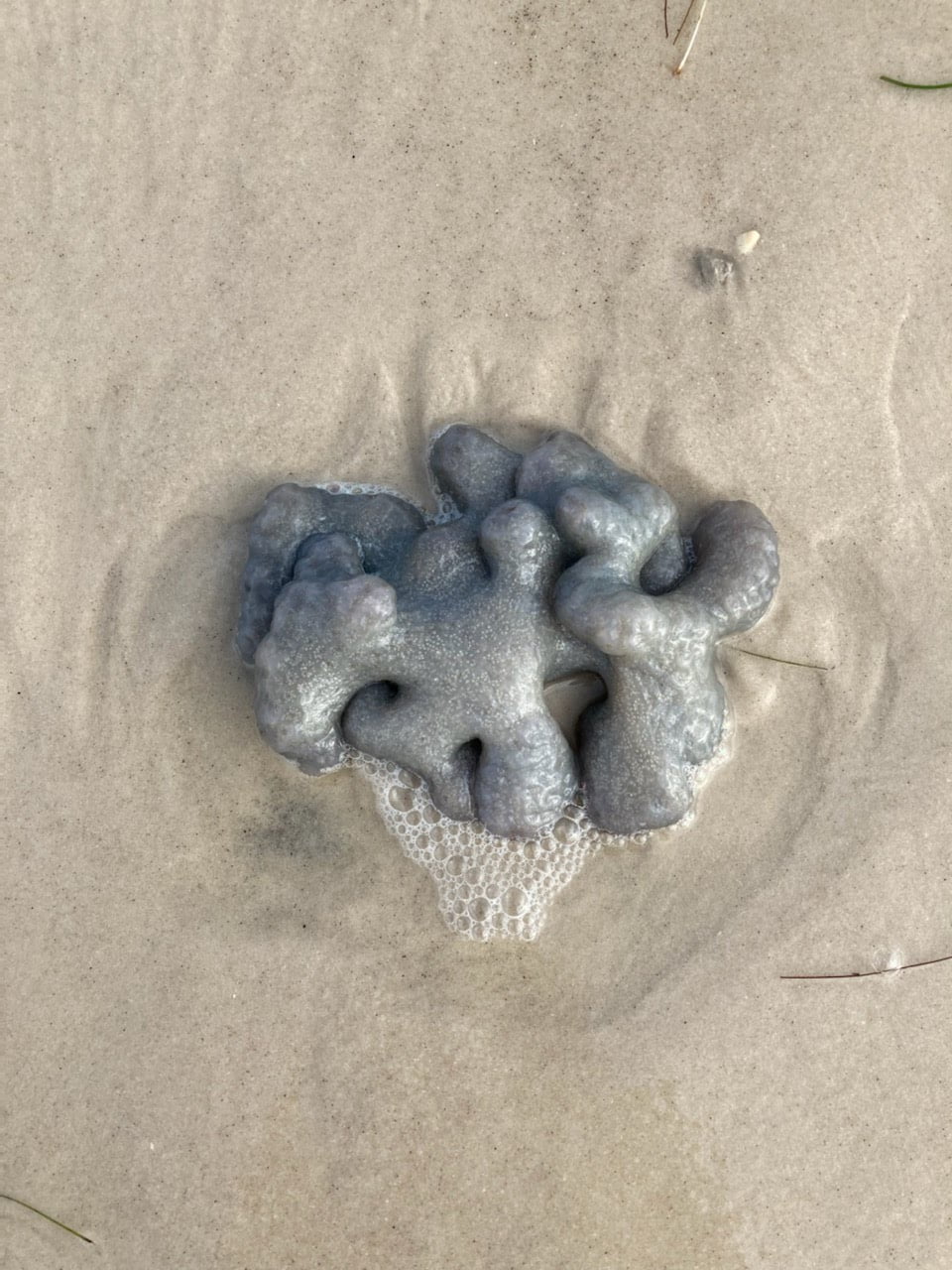
Tunicate or "Sea Pork"
Sent in by Suzanne P., Sep. 1, 2021.
This is Aplidium stellatum, a colony of microscopic-sized tunicates, or zooids. The zooids travel together, sharing a single "tunic," or leathery covering, which aids in protection from predators. A. stellatum colonies are also informally known as “sea pork” due to their semblance to a heap of meaty cuts. A. stellatum colonies can range in color from brownish pink, to grayish purple. Tunicates themselves are a highly diverse group of varying shapes, sizes, and colors. What unifies them into a single species is their similar anatomies and feeding styles. Every tunicate has two openings (siphons) used to constantly draw and expel water. They each have their own tunic or share a tunic with others of their species. Lastly, they are all filter-feeders, using a built in "strainer" to separate and consume microscopic organisms (ex. plankton, bacteria) from the seawater they take in. Interesting fact: Tunicates are members of the phylum Chordata, meaning that they are born with a backbone. This makes them more closely-related to humans than to say, sea sponges or jellyfish.

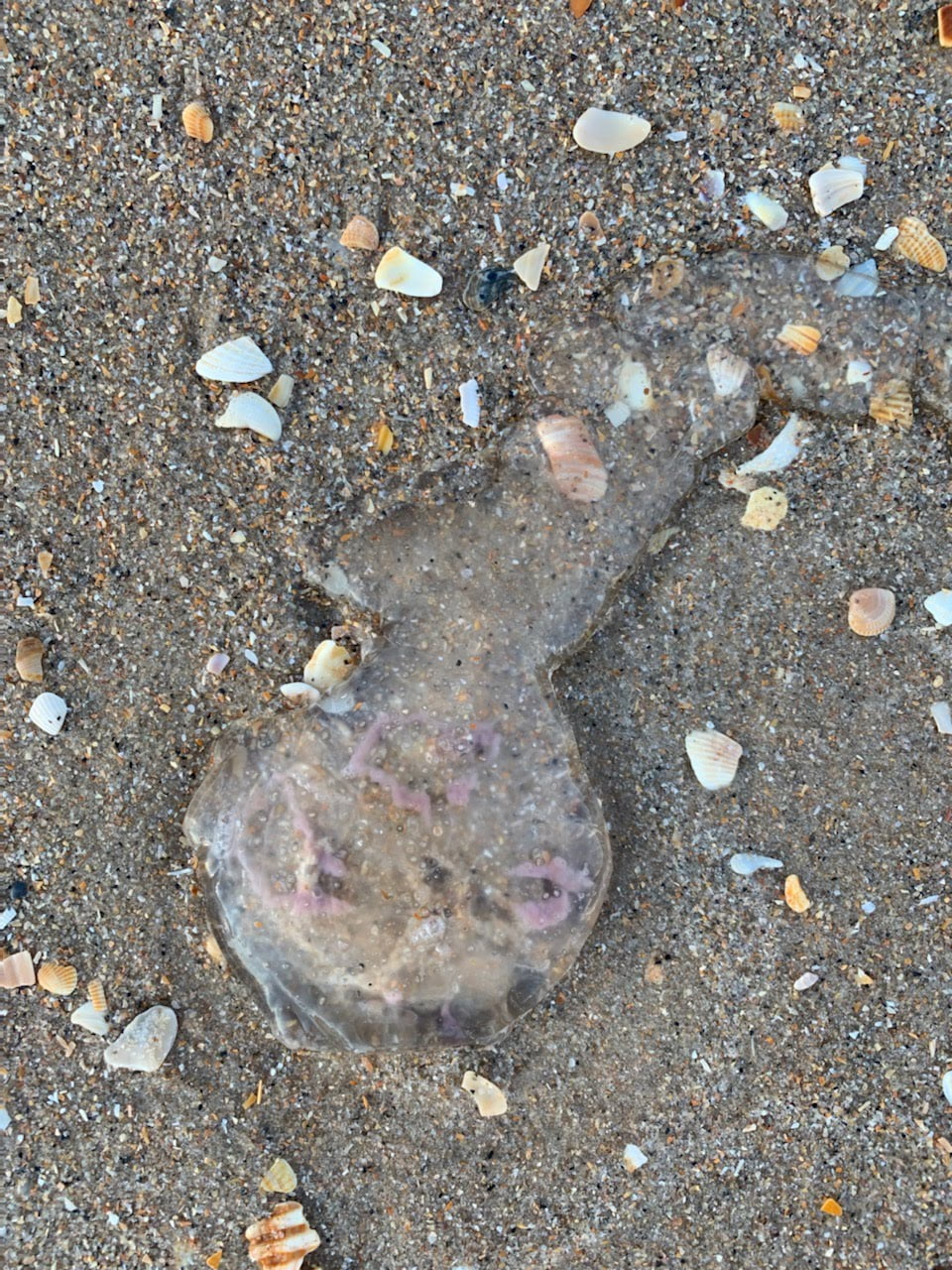
Moon Jelly
Sent in by Stephanie Hansen, Sep. 6, 2021.
That is a surf-tossed moon jelly (Aurelia aurita), otherwise known as a common jellyfish. As you may guess, they are the most common species of jellyfish and can be found in oceans all over the world. They are considered a non-dangerous jelly, as their stinging cells are very small and will only give a mild, hardly-noticeable sting to humans. Moon jellies are easily identified by the four purplish/pink gonad rings located in the center of their bell. Though this one is a bit torn up from heavy wind and wave action, you can still see remnants of its gonads. Fun fact: moon jellies are mainly predated on by sea turtles and sharks. Without these species, their population could skyrocket and become out of control. This is yet another reason why sea turtles and sharks are so important to the ocean's health, and why we are working to bring them back from endangerment.

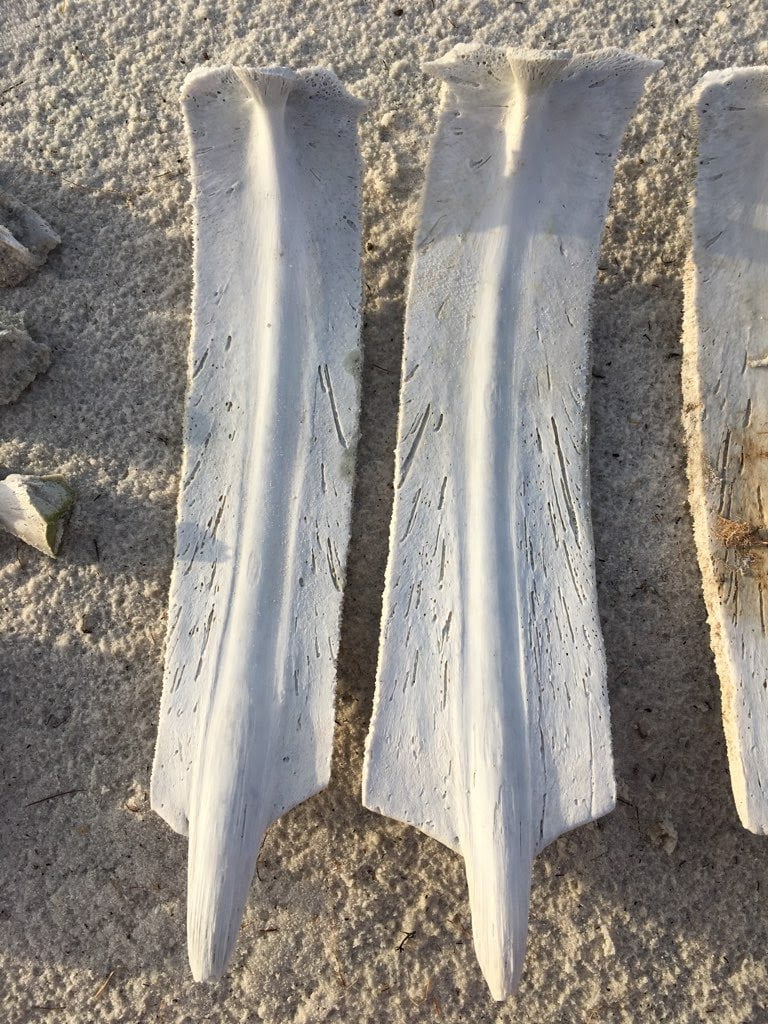
Sea Turtle Ribs/Carapace
Sent in by Meggan L., Aug. 27, 2021.
These are rib bones from a sea turtle. Ribs line the sea turtle’s carapace in rows of two, with the pointed ends facing outward to support the marginal scutes of the shell. It is difficult to tell the species of sea turtle without having its bones in hand to analyze. But given the length of the ribs (approximately 2 ft) and our location in the Panhandle, our best guess would be a Loggerhead sea turtle (Caretta caretta). The turtle was likely stranded at this location quite some time ago. With Tropical Storm Fred and other severe storms that have recently passed through the Gulf, its remains would have been uncovered by heavy wind and wave action. Interesting fact: all species of sea turtles are protected under the Federal Endangered Species Act of 1973 and Florida's Marine Turtle Protection Act. As a result, it is a felony to collect any parts of a sea turtle, alive or deceased, without a permit or other authorization from the federal and Florida state governments. Fortunately, we at ANERR have been permitted by both governments to collect sea turtle bones found on the beach for research and educational purposes, so the bones you saw here can also be found in our Discovery Room!

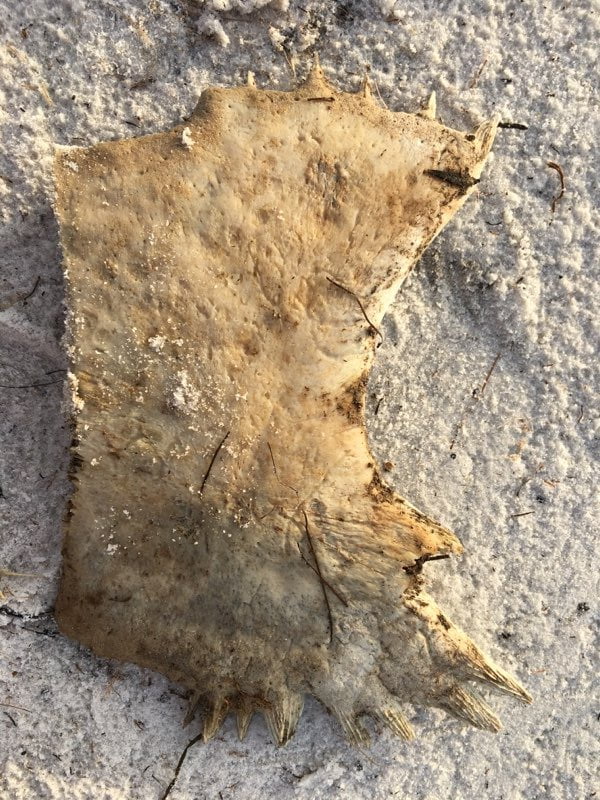
Sea Turtle Plastron
Sent in by Meggan L., Aug. 27, 2021.
This is a hypoplastron bone from a sea turtle. It is one of 9 bones that make up the turtle’s plastron, or the underside of its shell. The plastron bones start separate from one another in hatchlings, but eventually fuse together as the turtle grows older. It is difficult to tell the species of sea turtle from its bones without having them in hand to analyze. But given the length of the ribs you found along with the hypoplastron, and our location in the Panhandle, our best guess would be a Loggerhead sea turtle (Caretta caretta). The turtle was likely stranded at this location quite some time ago. With Tropical Storm Fred and other severe storms that have recently passed through the Gulf, its remains would have been uncovered by heavy wind and wave action. Interesting fact: all species of sea turtles are protected under the Federal Endangered Species Act of 1973 and Florida's Marine Turtle Protection Act. As a result, it is a felony to collect any parts of a sea turtle, alive or deceased, without a permit or other authorization from the federal and Florida state governments. Fortunately, we at ANERR have been permitted by both governments to collect sea turtle bones found on the beach for research and educational purposes, so the bones you saw here can also be found in our Discovery Room!

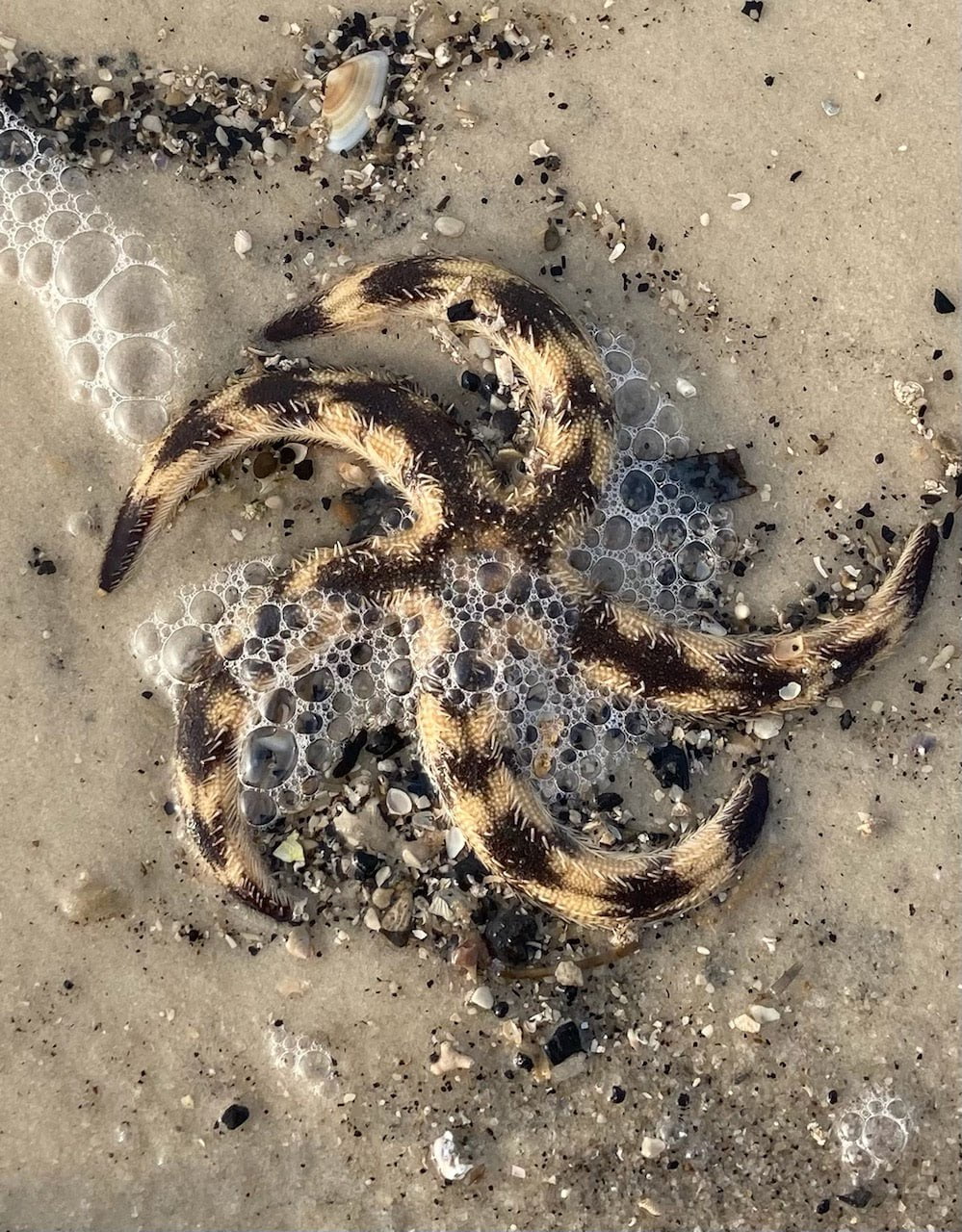
Banded Sea Star
Sent in by Suzanne P, Sep. 11, 2021.
This starfish goes by a few different names depending on who you ask, including soft bottom starfish, spiny sand star, limp sea star, and banded sea star. To avoid confusion, it is best to go by its Latin name, Luidia alternata. Like most starfish, L. alternata live in sandy shallows or seagrass, but can end up on the beach after heavy storms. This starfish is a bit different from other sea stars; rather than consuming bivalves such as clams, mussels, and oysters, L. alternata prey on other types of sea stars. Moreover, most species of starfish use their tube feet or "suckers" to pry open bivalves and extend their stomach directly into the shell. L. alternata just swallows their prey whole and regurgitates the indigestible stuff later. Fun fact: starfish are members of Echinodermata, a phylum that also includes sea cucumbers, brittle stars, sea urchins, and sea lilies. Members of Echinodermata are related in that they have radial symmetry, spiny skin, and rows of tube feet to help them move around and hunt.

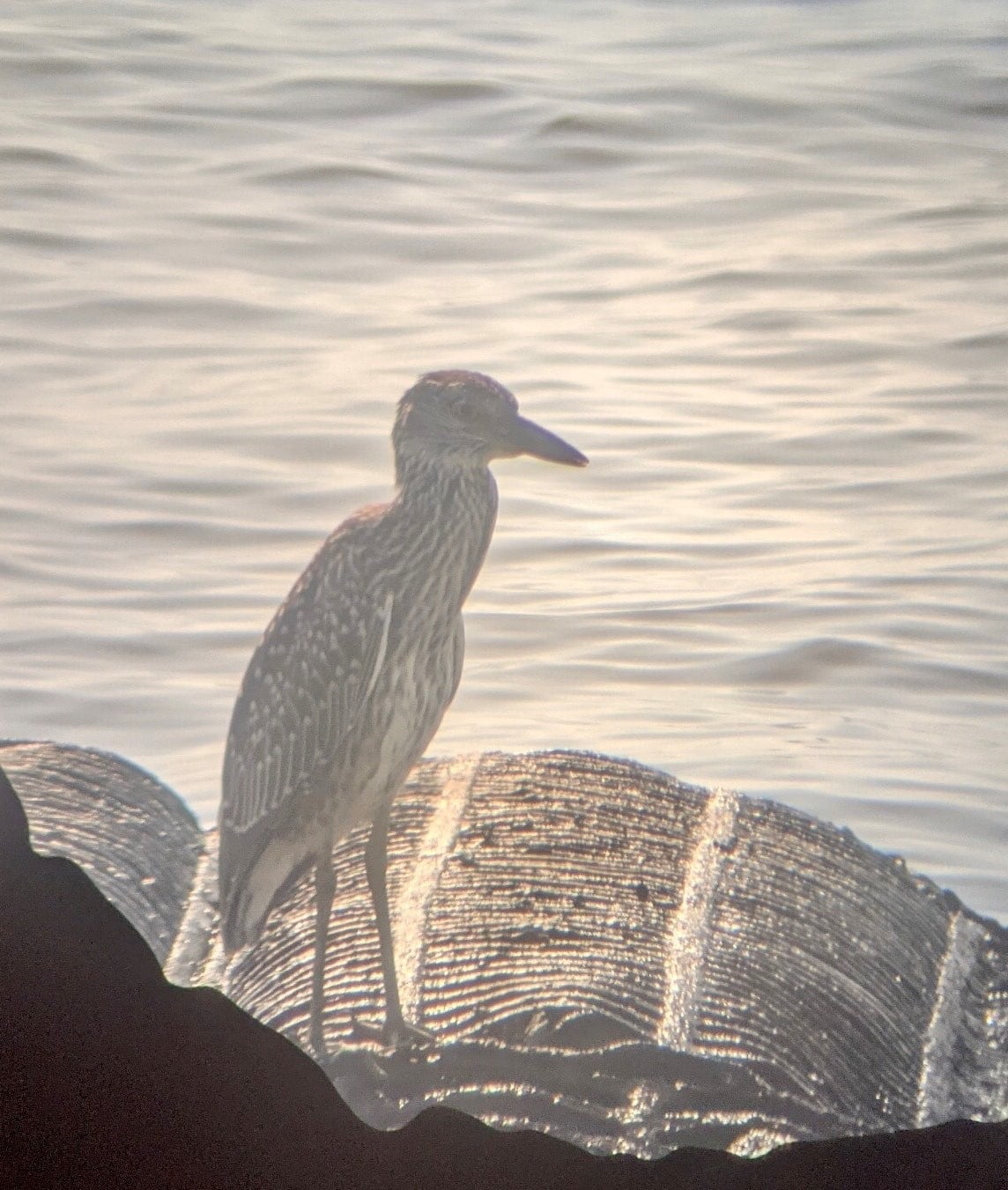
Juvenile Night Heron
Sent in by Anonymous.
That is Nyctanassa violacea, a yellow-crowned night heron (juvenile-aged). They are a stockier variation of heron, but nonetheless exhibit the same “elegance” in carefully stalking through shallow wetlands. Yellow-crowned night heron prey on crabs and crawfish and will only nest in areas that host a large population of either species. Apalachicola Bay is a perfect habitat for them in this aspect! Yellow-crowned night herons are a close relative of black-crowned night herons. While adults of each species are easy to distinguish between, juveniles are more-easily confused. Juvenile yellow-crowned night herons can be identified by the white edging that outlines each of their wing feathers (black-crowned juveniles lack this edging). Interesting fact: yellow-crowned night herons were exterminated from the island of Bermuda by early settlers. Their absence allowed local land crab populations to skyrocket out of control. The yellow-crowned night heron was successfully reintroduced to Bermuda in 1976. Crab populations declined back to normal levels, demonstrating the important ecological role of night heron.

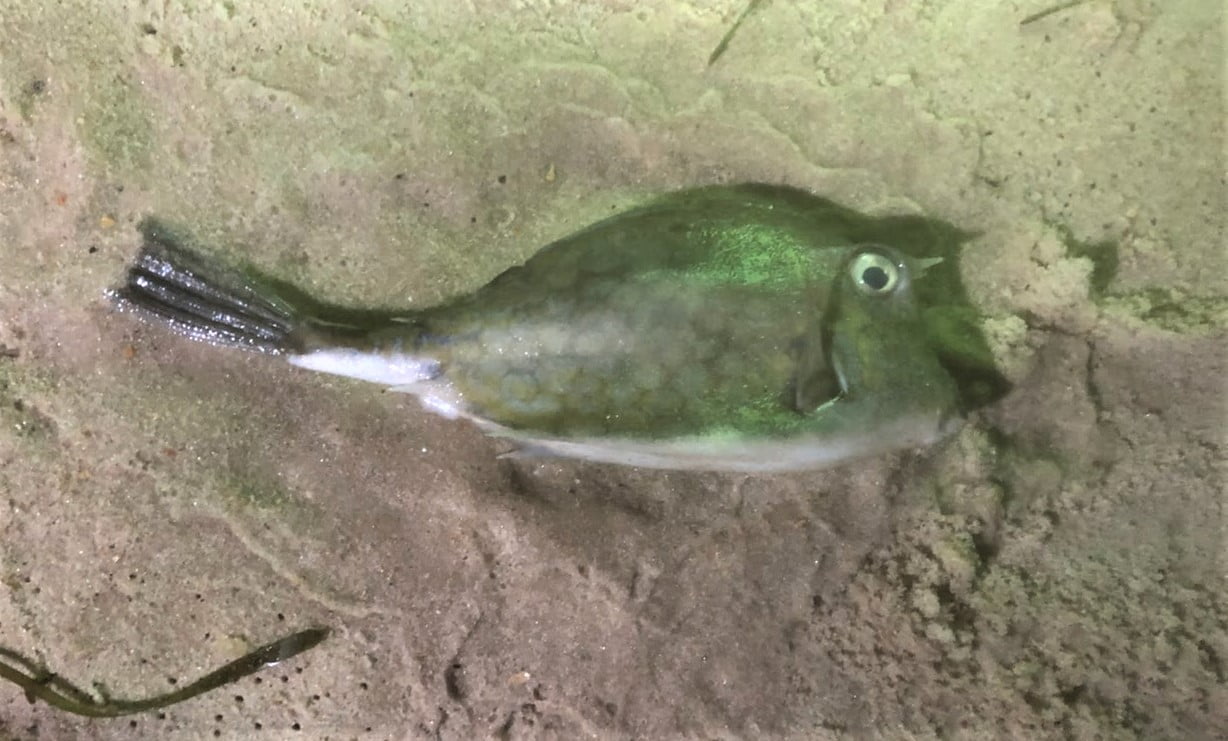
Scrawled Cowfish
Sent in by Jason Daugherty, Oct. 5, 2021.
That is Acanthostracion quadricornis, a scrawled cowfish. Cowfish are a shallow-water species that often occupy seagrass. They feed on marine plants as well as slow-moving or sessile organisms such as hermit crabs, sponges, and anemones. Living scrawled cowfish are covered in vibrant blue scrawling patterns, but these patterns quickly fade after they pass. Interesting fact: similar to a crab or turtle, cowfish are armored by a carapace. This "shell" of theirs is made up of tiny hexagonal plates, which you can still see the outlines of on this specimen. Likely because of this defensive mechanism, they do not have any major predators. They can be eaten by humans, and often are in the Caribbean and Pacific. However, they must be prepared carefully and cooked thoroughly, as their body contains a toxic poison known as Palytoxin.

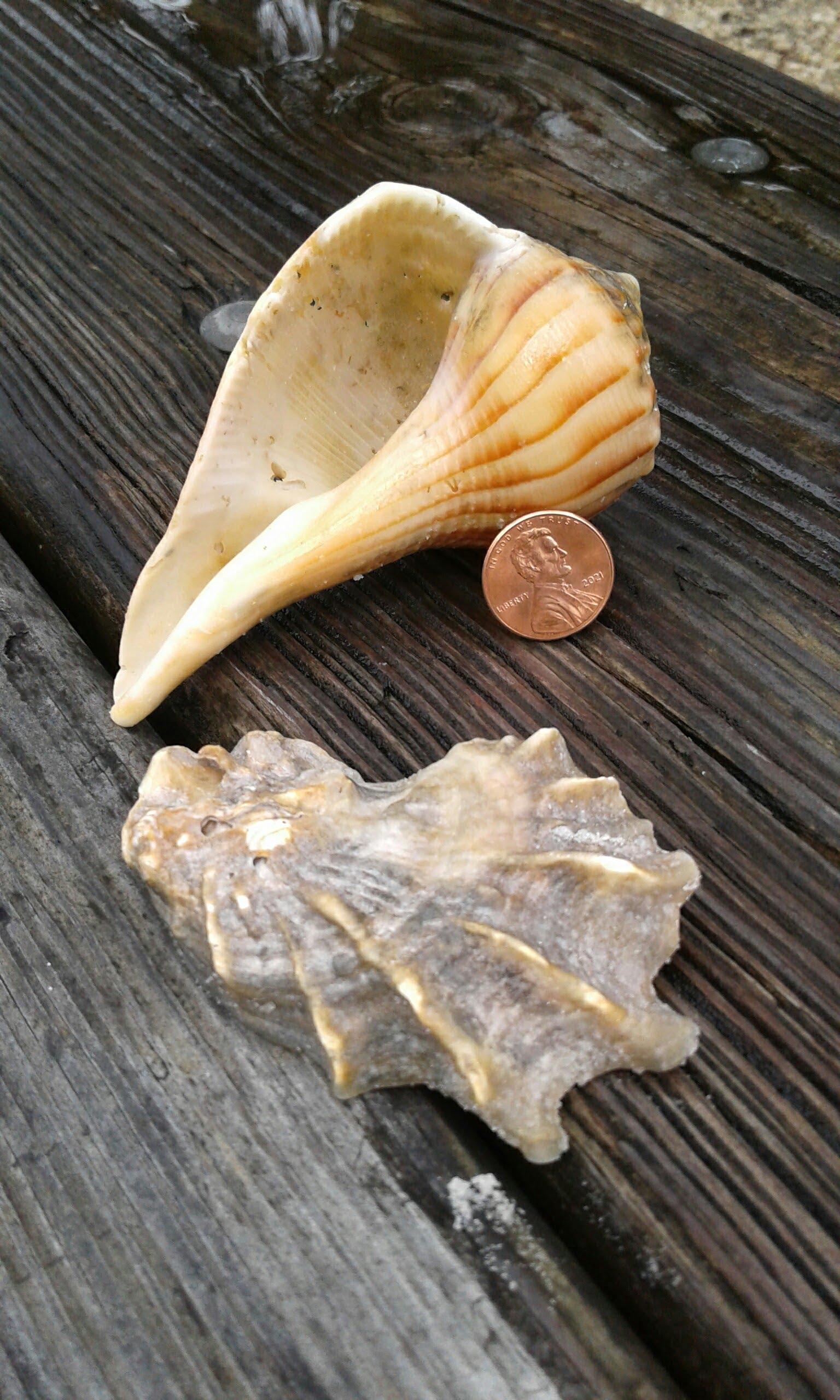
Lightning Whelk and Easter Oyster shells
Sent in by J. Brown, Sep. 15, 2021.
That is a lightning whelk shell, Sinistrofulgur sinistrum, and an Eastern oyster shell, Crassostrea virginica. Both are common to our area. Lightning whelks can usually be identified by their large, knobby whorl, cream color with brown axial streaks, and left-handed (sinistral) aperture. For most other marine snails, being left-handed is a rare abnormality that results in sterility. Being a "lefty" has its advantages for lightning whelks. For instance, they are more likely to survive predation attempts by stone crabs, who's crusher claw is always on the right side. Eastern Oysters have highly variable shells of many shapes, colors, and outer surface textures. Their inner surface is always smooth with a purple muscle scar. The outer surface of the oyster shell you have here is significantly ridged, most likely due to the oyster "growing up" in a tighter space than usual.

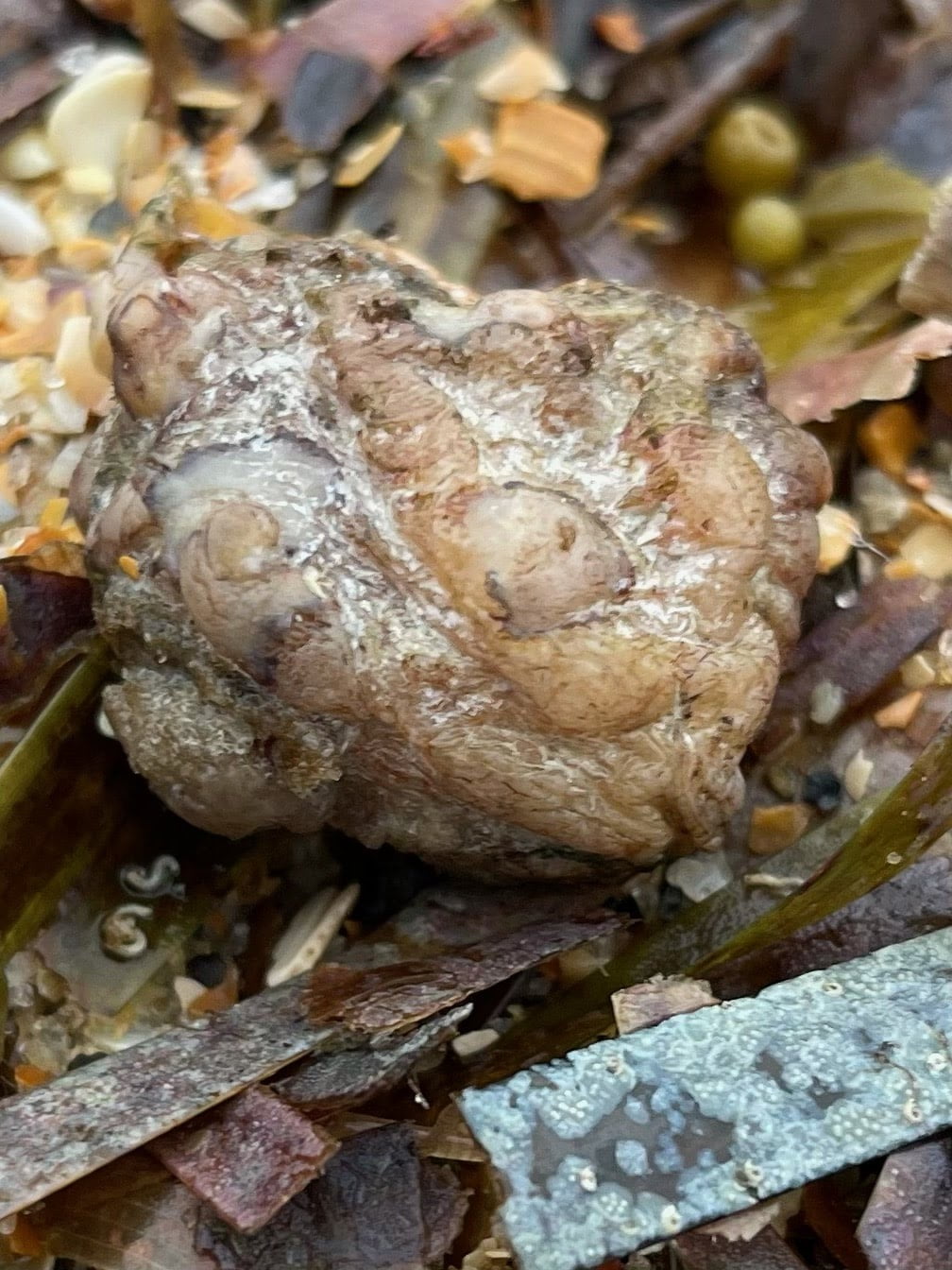
Sandy-skinned Tunicate
Sent in by Amanda Lenning, Sep. 17, 2021.
That is Molgula occidentalis, a sandy-skinned tunicate or "sea squirt.' Adult tunicates are immobile (sessile) beings that come in a wide variety of shapes, colors, and sizes. What unifies them into a single species is their basic anatomy and feeding style. Every tunicate has two openings (siphons) used to constantly draw and expel water. Moreover, they each have a "tunic", or leathery covering, to aid in protection from predators. Lastly, they are all filter-feeders, using a built in "strainer" to separate and consume microscopic organisms (ex. plankton, bacteria) from the seawater they take in. The sandy-skinned tunicate is one of the most common species you'll find in Florida waters. Interesting fact about all tunicates: they are in the phylum Chordata, meaning they are born with a backbone. This makes them more closely-related to humans than to say, sea sponges or jellyfish.

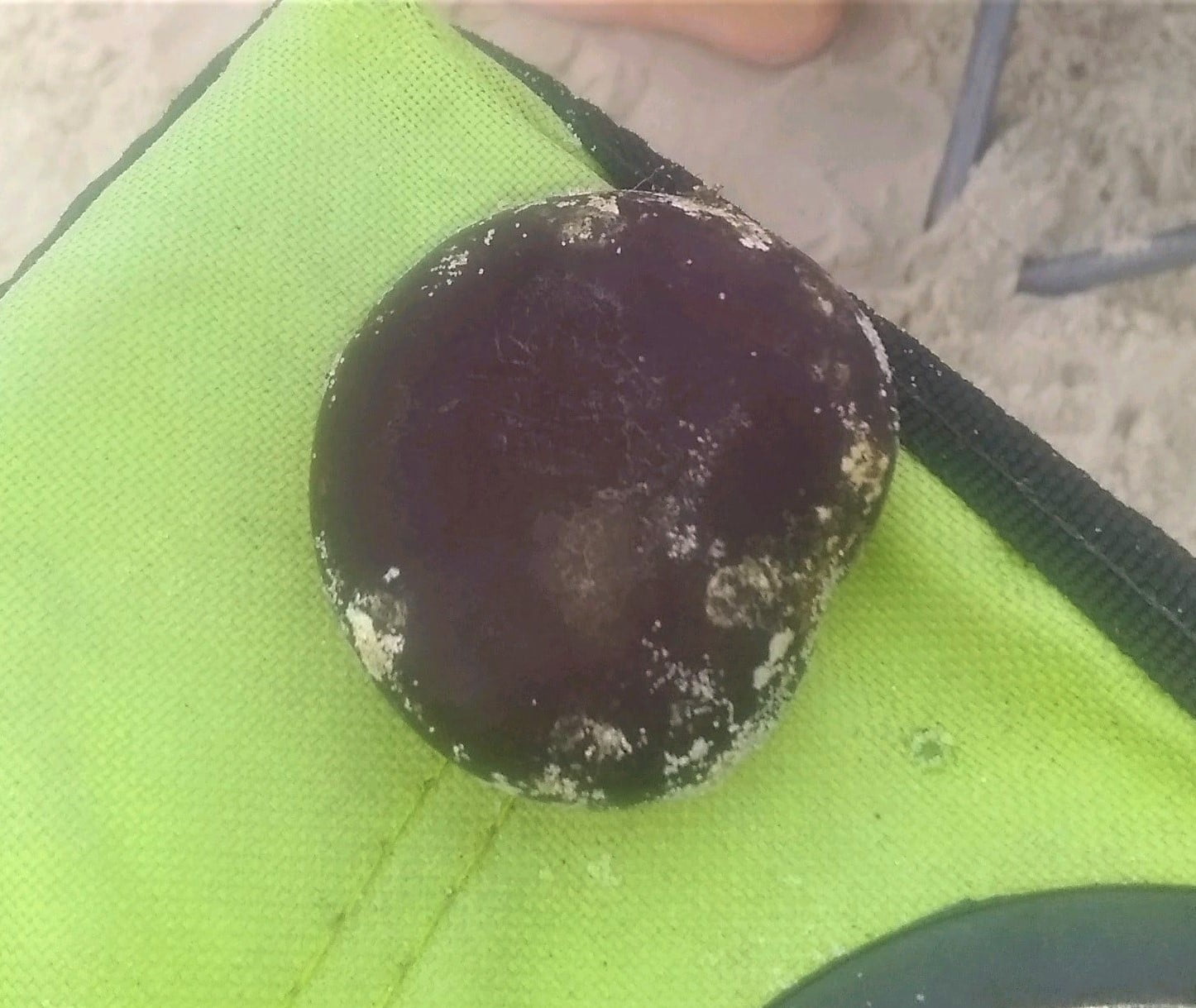
Sea Heart
Sent in by Anne Myers, Sep. 16, 2021.
This is a drift seed of Entada gigas, a creeping-type legume plant native to Central America, the Caribbean, and northern regions of South America. The seeds are commonly known as "sea hearts," given their heart-shape and ability to float through the sea due to an air pocket within their casing. The journey of this drift seed is quite fascinating: after maturing and detaching from an E. gigas plant, it most likely fell into a nearby river where it was eventually taken out to sea. Here, it would have been picked up by the North Atlantic gyre and brought into the Gulf. It was likely pulled out of the gyre and deposited onto our beach with all the strong storms that keep passing through. This journey might take only a few days, or it could take up to thirty years, depending on wind and ocean current conditions. Interesting fact: since E. gigas is nonnative as well as highly invasive, sea hearts should not be planted here in Florida. However, they are one of many drift seeds that can be polished and kept on display, or even used to make jewelry. There's a growing market for sea bean jewelry on art/craft online marketplaces, such as Etsy.

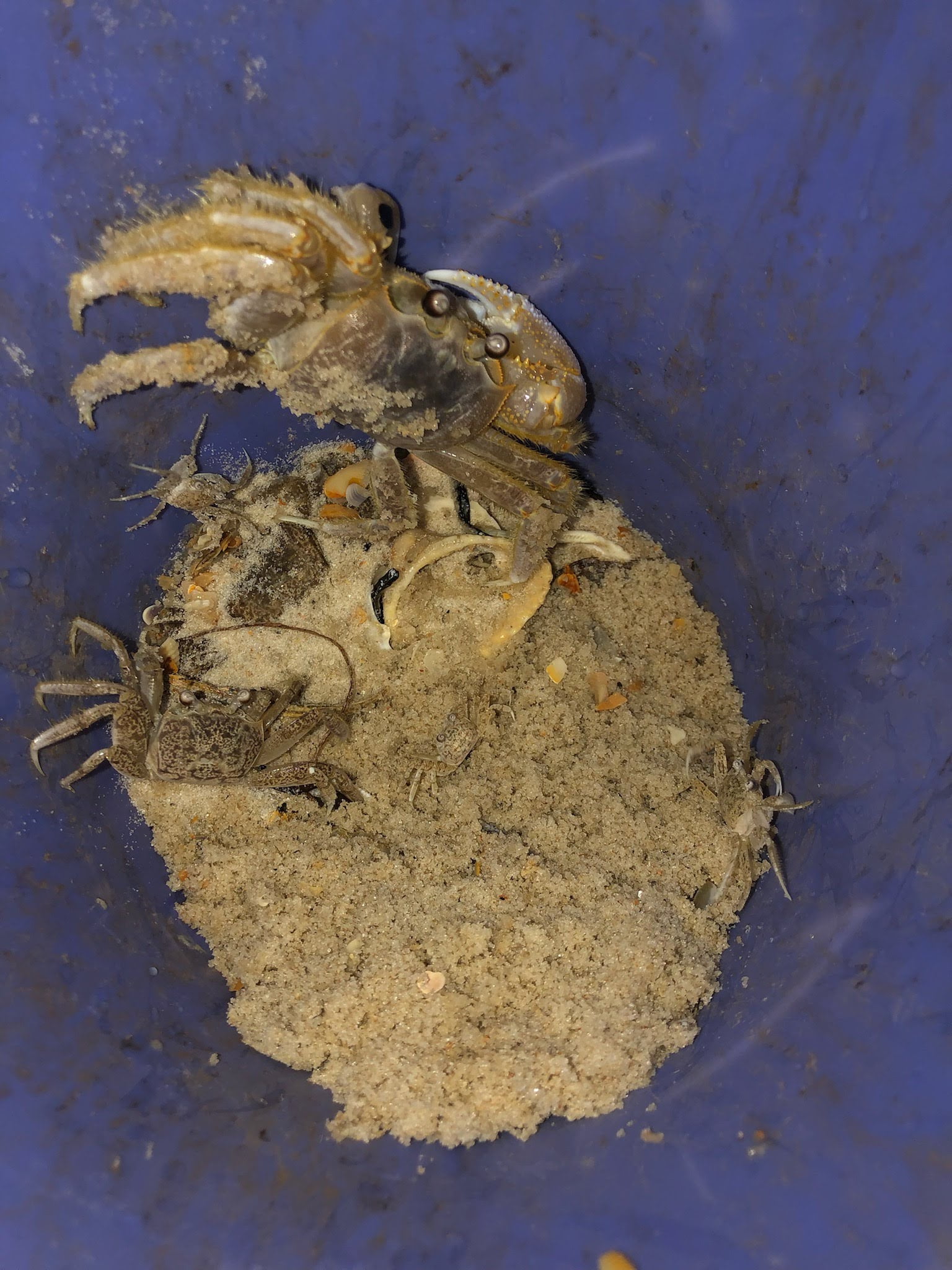
Ghost Crabs
Sent in by Anonymous, Sep. 29, 2021.
Here you have a collection of juvenile Atlantic ghost crabs (Ocypode quadrata) as well as what appears to be an adult or near-adult ghost crab at the top of the bucket. While ghost crabs are usually known for their pale-yellow and white color, they have the ability to dull their color in order to blend with darker sands. Juvenile ghost crabs are often already a little darker-colored than adults and have a mottled pattern on their carapace (as seen with the smaller crabs at the bottom of your bucket).

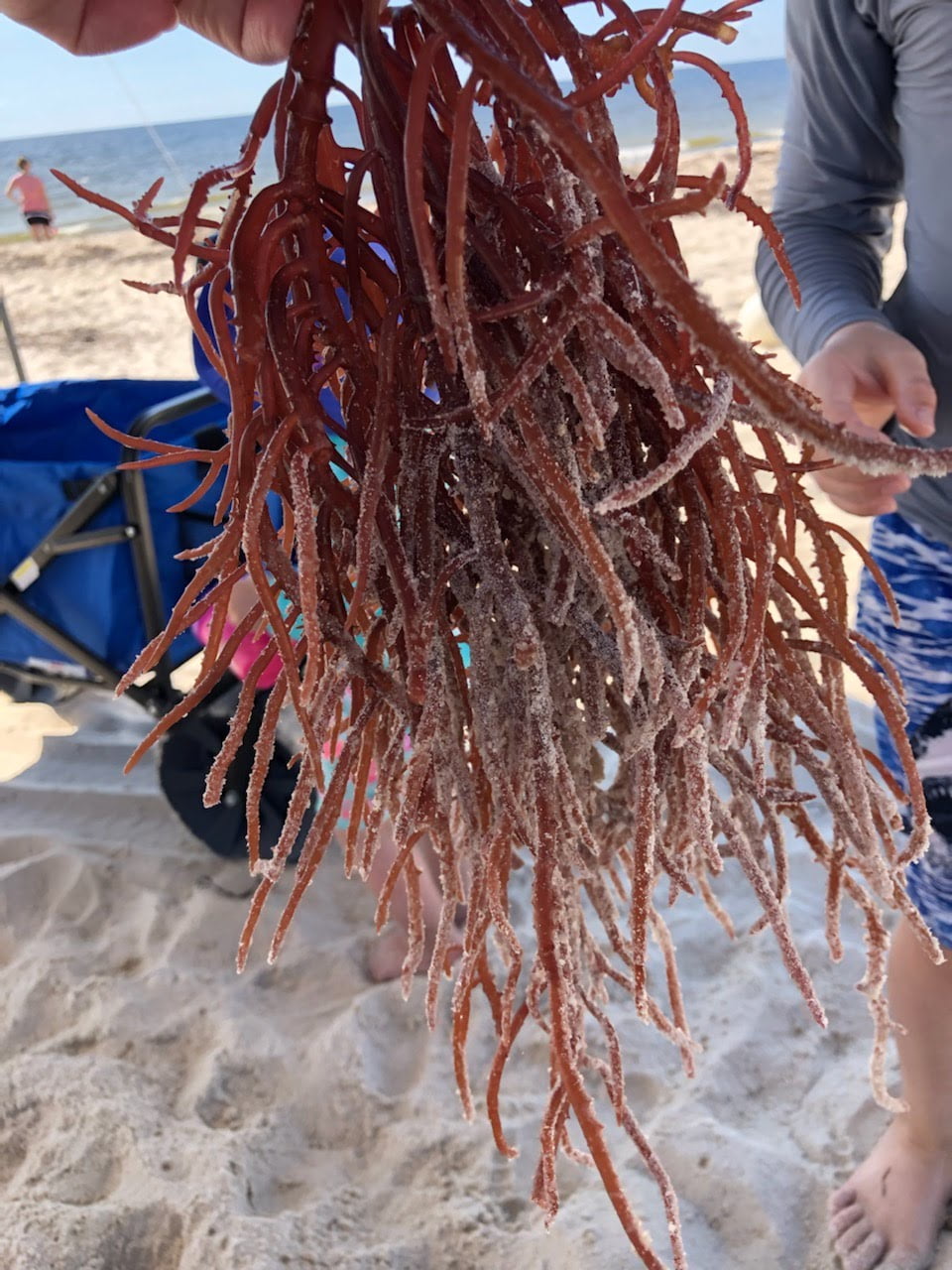
Graceful Redweed
Sent in by Anonymous, Sep. 29, 2021.
This is freshly-beached Gracilaria tikvahiae, commonly known as graceful redweed. Graceful redweed is a type of red seaweed, which in itself is multicellular algae very similar to plants but lacking any stems, leaves, or roots. Graceful redweed has bright red forked branches that can span up to a foot long and is often said to resemble a tangled clump of red spaghetti. After washing up it quickly bleaches clear, so the one you found here must have been a very fresh specimen.

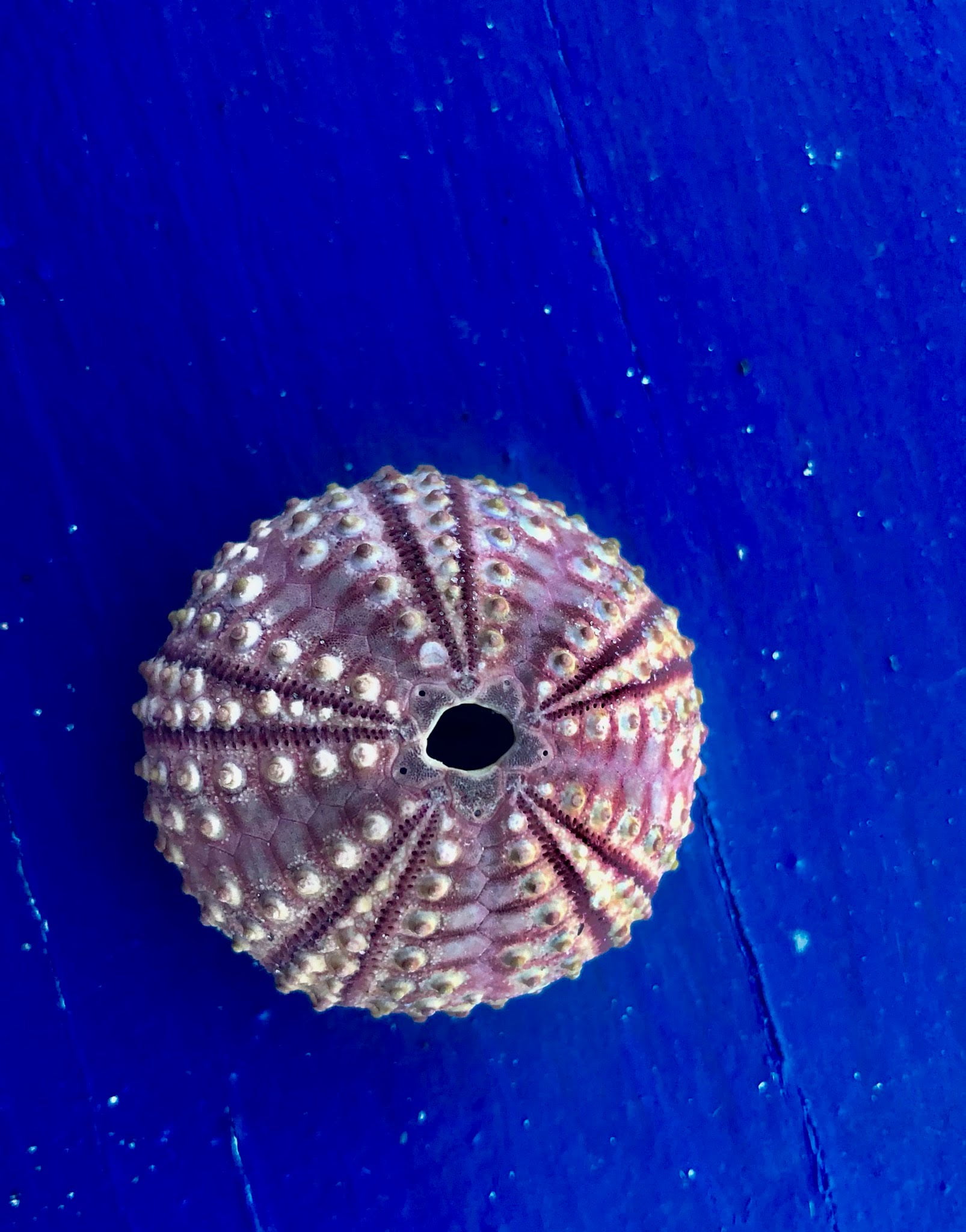
Purple-spined Sea Urchin
Sent in by Anonymous, Nov. 13, 2021.
That is the test (shell) of Arbacia punctulata, a purple-spined sea urchin. Once the urchin passes and its test is exposed to the elements, it easily bleaches into a more familiar off-white color. This urchin must have passed and lost its coat of spines quite recently before you found it, given the vibrant color that remains as well as its undamaged state. Interesting fact: purple-spined sea urchins are common subjects in studies of cell-mediated immune system responses and embryology. This is due to their fertilization being an external process, as well as their size and abundance that allows for easy observation, manipulation and sampling.

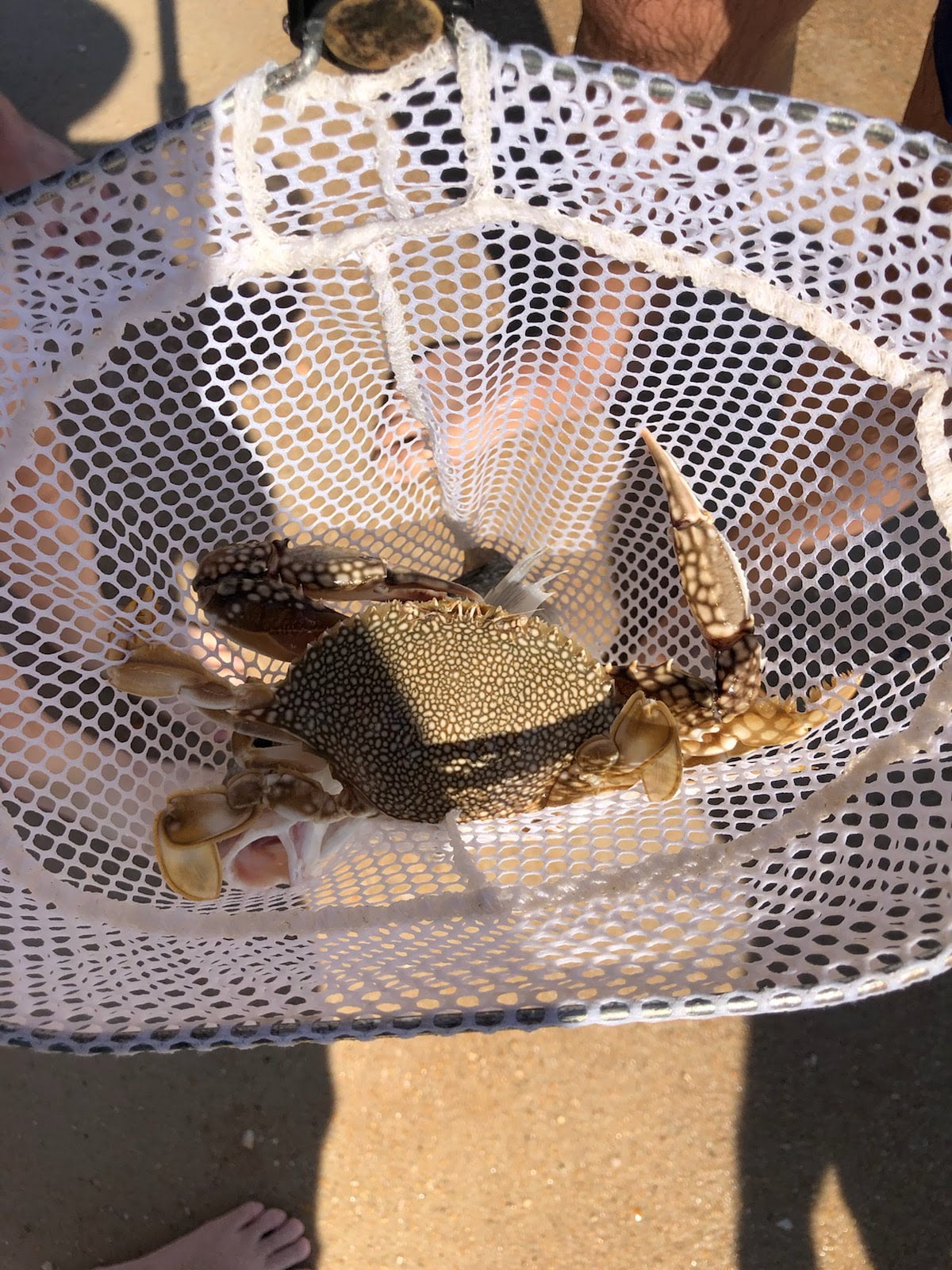
Speckled Swimming Crab
Sent in by Anonymous, Sep. 29, 2021.
That is Arenaeus cribrarius, a speckled swimming crab. Swimming crabs are a group of crabs where their fifth and hindmost pair of legs have been shaped into paddles to aid in swimming. Speckled crabs are common to this area and can be identified by these paddles along with their gray-tan carapace with white speckles. While the name makes you think these guys are regular swimmers, they actually prefer to stay on the sea floor to scavenge detritus and hunt worms, mollusks, small fish, and other crabs. Speckled crabs are known to wait buried beneath the sand to ambush their prey but will also aggressively chase down anything they don't catch on their first attempt. As for their ecosystem role: they are the "cleaners" of the ocean floor, consuming detritus that would otherwise build up and pollute the environment. They are also a major food source for the endangered Loggerhead sea turtle and Kemp's Ridley sea turtle. Though prickly and quick to aggress, they are a good species to have around!

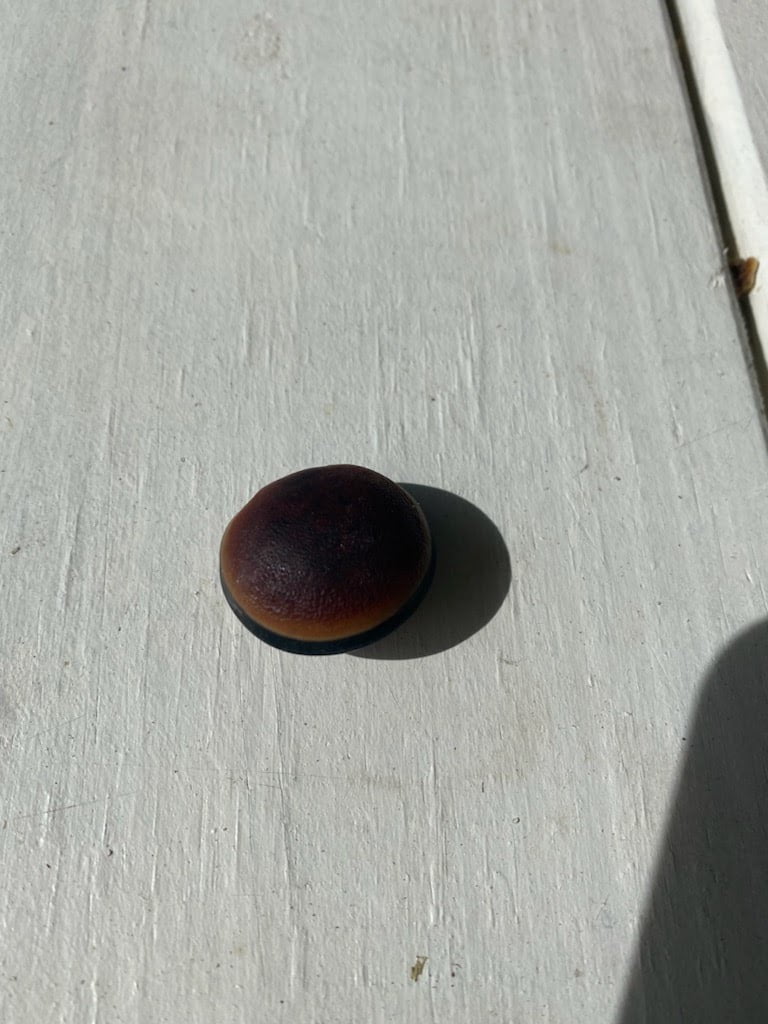
Brown Hamburger Bean
Sent in by Emily Howard and Greg Seals, Oct. 18, 2021.
That is a Mucuna sloanei drift seed, also known as a brown hamburger bean. M. sloanei is a climbing vine native to Central and South America rainforests. Drift seeds are well adapted for oceanic travel; they are both extremely buoyant and highly durable. The journey of this seed is quite fascinating: after maturing and detaching from an M. sloanei plant, it likely fell into a nearby river where it was eventually taken out to sea. Once far enough out, it would have been picked up by the North Atlantic gyre and by this current brought into the Gulf. From there, it was likely pulled out of the gyre by a passing storm and deposited onto the beach. This journey might have taken only a few days, or it could have taken years, depending on where the seed originated from and wind and ocean current conditions. Interesting fact: brown hamburger seeds are one of many drift seeds that can be polished and kept on display, or even used to make jewelry. There's even a growing market for sea bean jewelry on art/craft online marketplaces, such as Etsy.

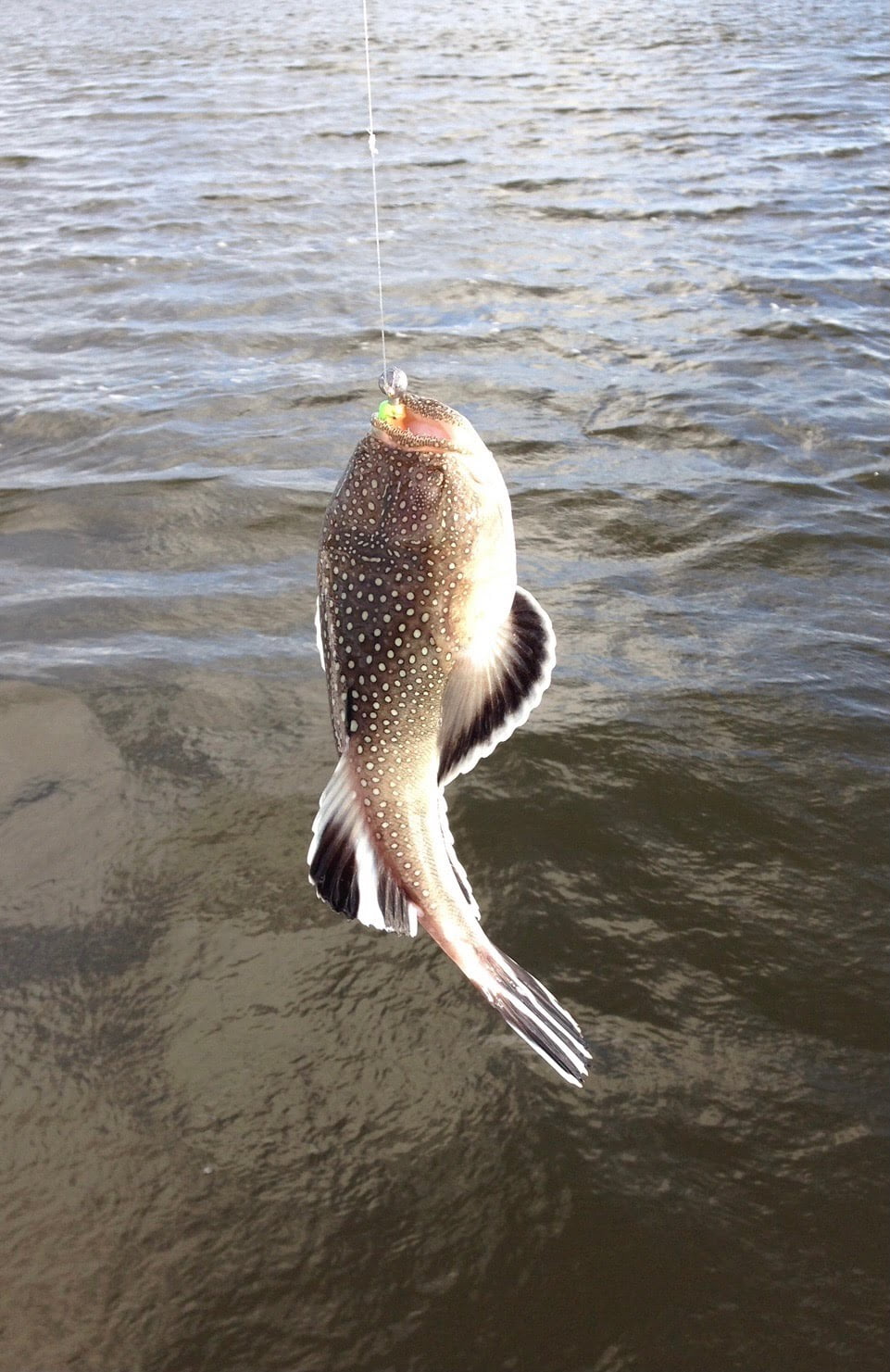
Southern Stargazer
Sent in by Emily Howard and Greg Seals, Nov. 6, 2021.
That is Astroscopus y-graecum, a southern stargazer. It is an inshore, benthic species well adapted for spending its life buried in the sand. Here, it waits patiently to ambush any small fish unlucky enough to swim by, swallowing them whole. Careful while handling these guys! Behind their eyes is a special organ able to charge and release an electric shock of up to 50 volts (for reference, wall outlets produce approximately 120 volts). It is used defensively to ward off any potential predators.

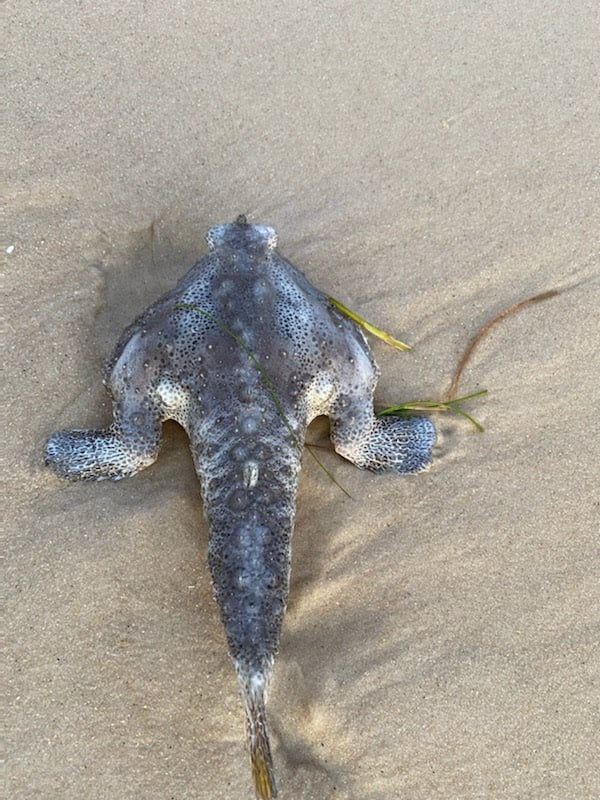
Polka-dot Batfish
Sent in by Jay Coutta, Oct. 18, 2021.
This is Ogcocephalus cubifrons, a polka-dot batfish. It is a benthic species, meaning it spends its life at the bottom of the seafloor, scavenging the muddy sediment for slow-moving prey such as small crabs, shrimp, or worms. It could have ended up as shrimp trawl bycatch, perished within the net, and was later thrown back into the water after the shrimpers sorted through their catch, or it could have been a red tide kill. Polka-dot batfish are often confused with shortnose batfish but can be differentiated by the distinctive spots on their fins that shortnose batfish lack. Interesting fact: when startled by a predator, batfish can use their fins to scurry away as if they were on legs! The way this one's fins are positioned, you can actually see how they would bend to allow the batfish to walk.

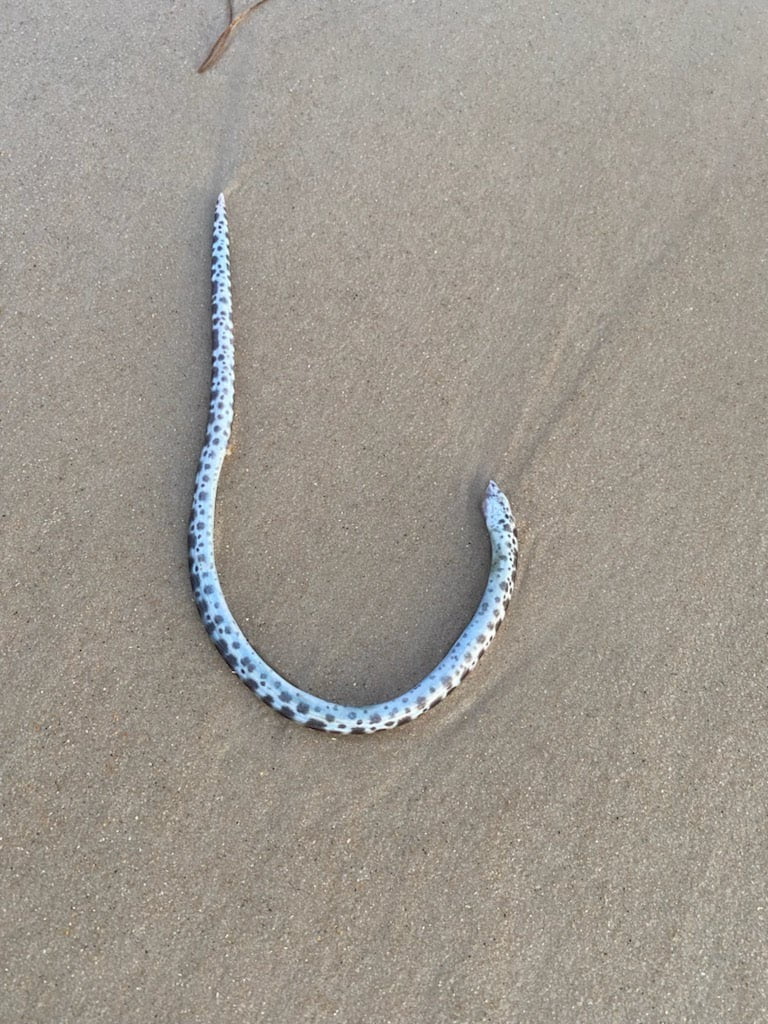
Spotted Spoon-nose Eel
Sent in by Jay Coutta, Oct. 14, 2021.
Given its jaw shape, its dark, clearly defined body spots, and what appears to be the presence of a pectoral fin, we believe this is Echiophis intertinctus, a spotted spoon-nose eel. Spotted spoon-nose eels are an inshore, bottom-dwelling species found on both Florida coasts. Not much is known about their biology or life habits. While living, these eels are quite elusive and rare to spot unless you are diver exploring underwater crevices or reefs. Unfortunately, it is only during red tide events that we see so many of them in one place. Eels seem to be especially sensitive to the red-tide causing algae Karenia brevis, though we are not quite sure as to why.

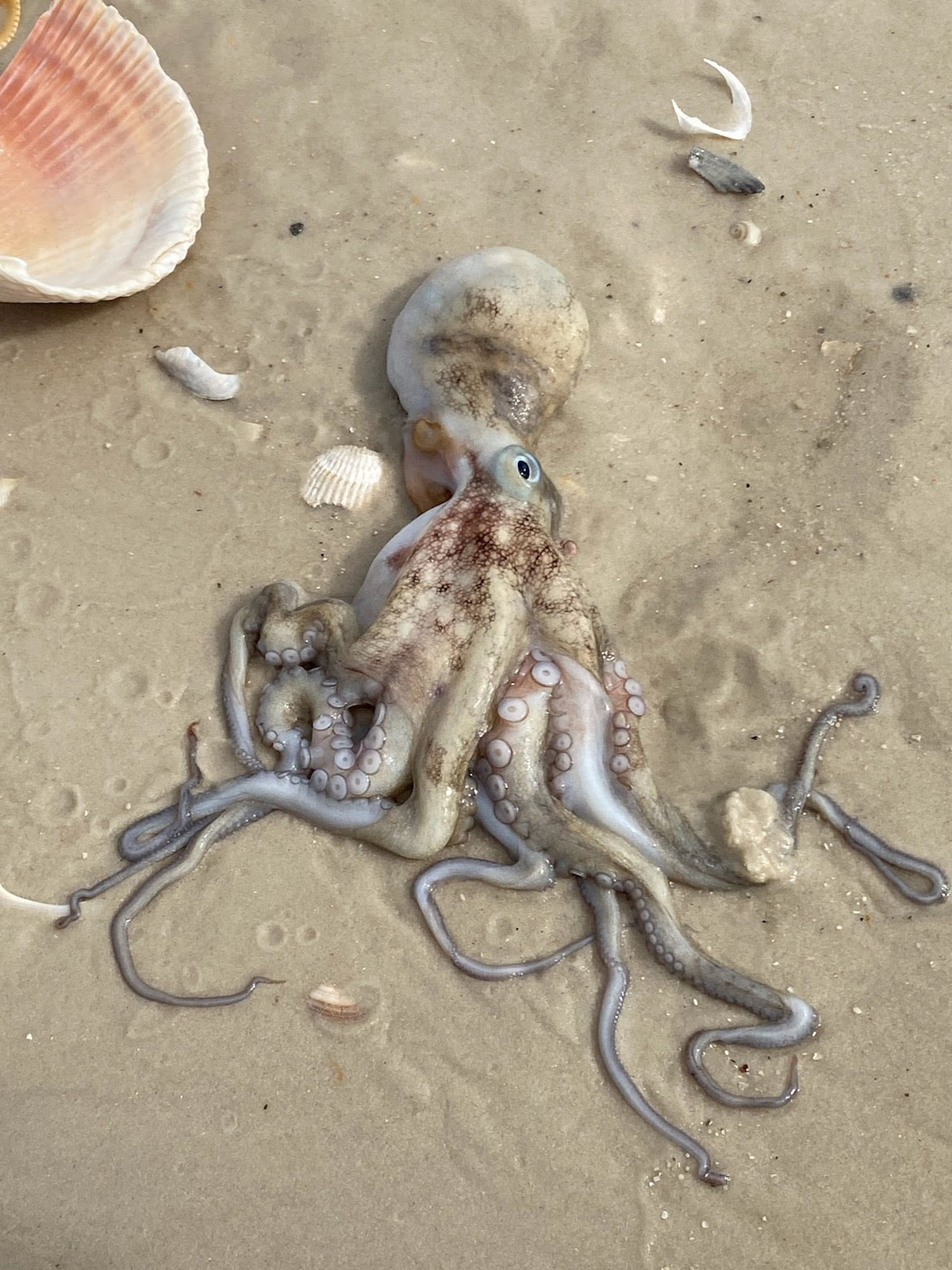
Atlantic Pygmy Octopus
Sent in by Joy Evans, Nov. 4, 2021.
This octopus could have been a red tide kill, or it may have been cold-stunned by today's temperature drop and washed onto the beach. Given its small size, it is likely an Atlantic pygmy octopus (Octopus joubini). Pygmy octopi are found within coastal waters across the Gulf of Mexico as well as in some parts of the Caribbean. They grow only to a maximum of about 6 inches long. Still, they are well equipped to face the threat of predation. When feeling stressed, these tiny guys will hole up in the closest shell or rock they can find. Conch shells are some of their favorite hiding places! They are also able to change their color to blend with their surroundings. If directly confronted, they will release ink to temporarily blind a predator.

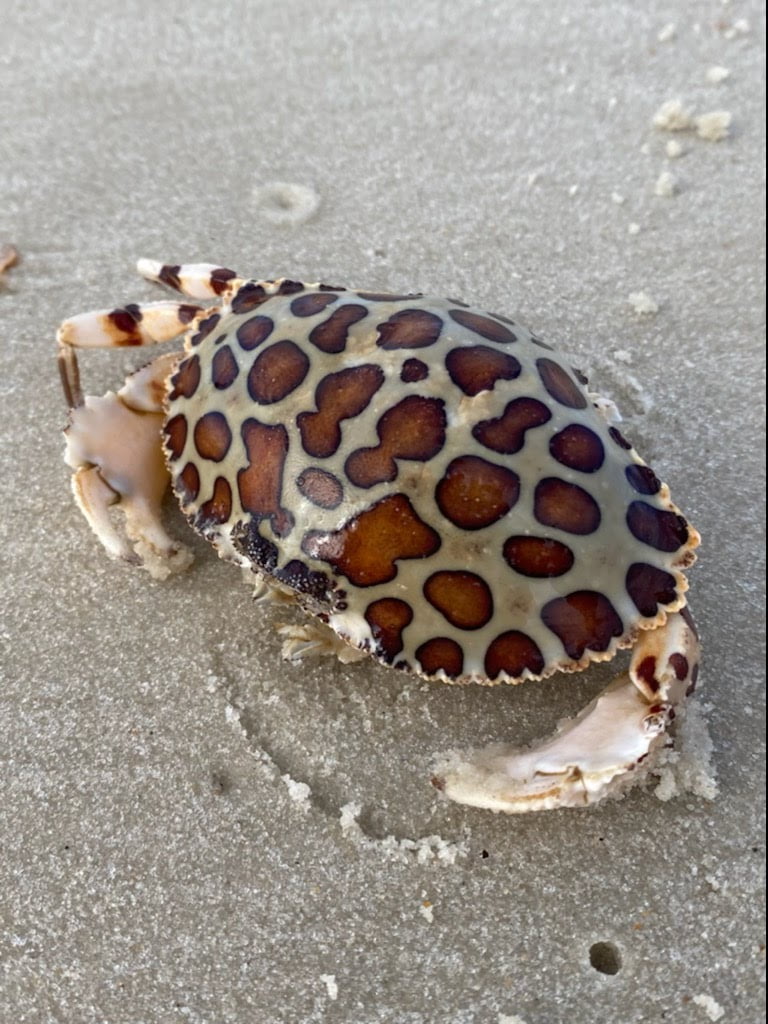
Calico Box Crab (molt)
Sent in by Joy Evans, Nov. 4, 2021.
The crab you found is likely a molt rather than a dead crab, especially if you did not notice a foul smell coming from it. It is from a Hepatus epheliticus, a calico box crab. Calico box crabs are common to this area, but they and their molts are a less common find along the beach. They are more often caught as bycatch during trawl or net fishing. They, like most crabs, can be quite aggressive when feeling threatened. As for their ecosystem role: they are the "cleaners" of the ocean floor, consuming detritus that would otherwise build up and pollute the environment. Though prickly, they are a good species to have around! Interesting fact: Calico box crabs often have a mutualistic relationship with hitchhiking anemones. This type of anemone will attach to the crab's carapace and ride around on its back. While the anemone gains greater access to food, the crab is protected from predators by the anemone's stinging cells!

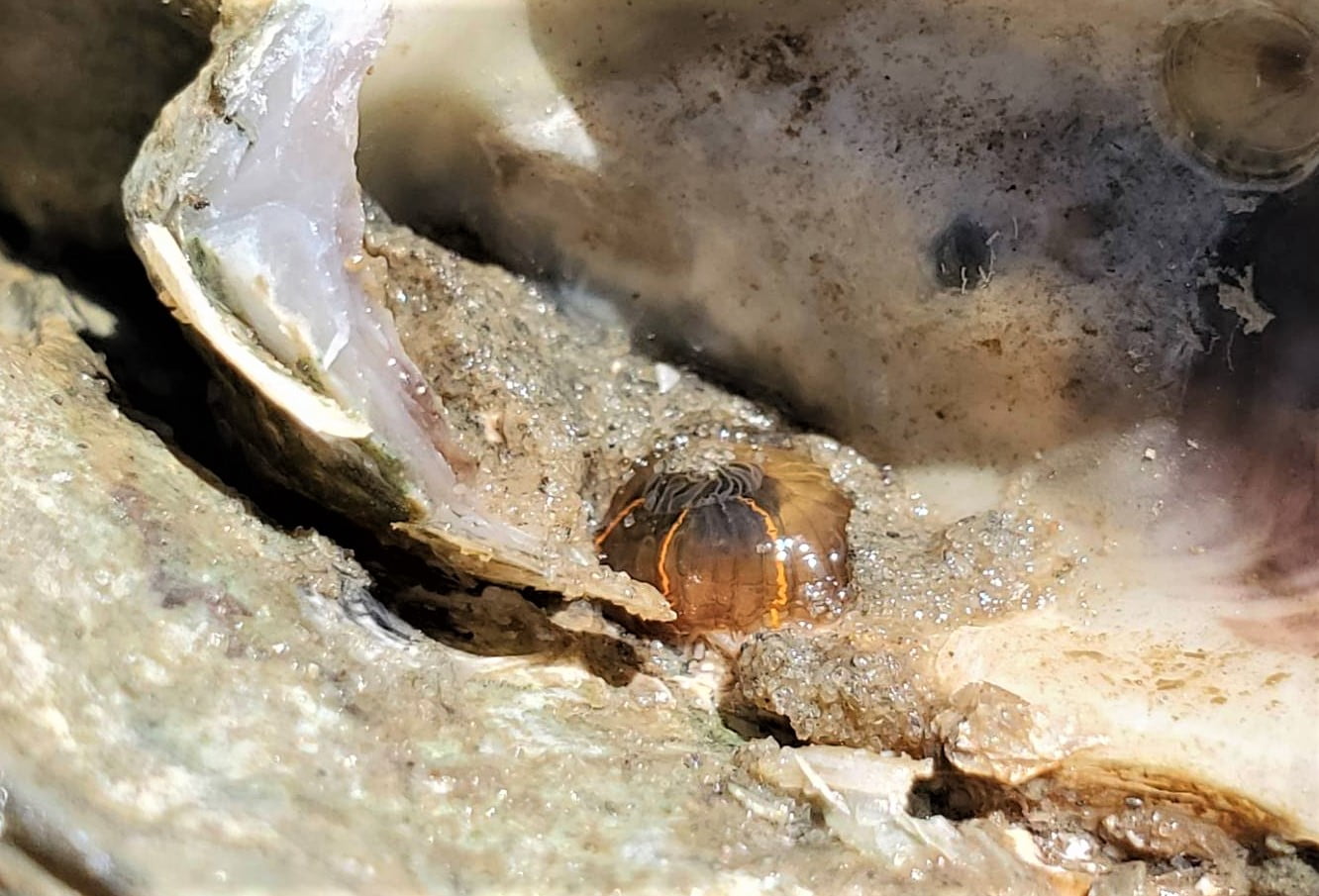
Orange-striped Sea Anemone
Sent in by Kennedy H, Nov. 3, 2021.
Diadumene lineata, an orange-striped sea anemone. This is a small anemone maturing at just under one inch tall. 50-100 tentacles form a crown around the mouth, which fully retract into the body column when the anemone is stressed (the pictured anemone has fully retracted). Orange-striped anemones live attached to hard substrate such as rocks, docks and ships, and even oyster, clam, or snail shells. The one you found here seems to have made its home on an oyster shell. The orange-striped anemone is native to the Western Pacific but was unintentionally introduced to ecosystems worldwide as biofouling on trade ships in the late 1800s. While the orange-striped anemone is nonnative to the Gulf of Mexico, it is not considered a harmful species. No economic nor ecological impacts have been reported in response to their introduction to new environments.


Shortnose Batfish
Sent in by L.R., Sep. 20, 2021.
That is Ogcocephalus nasutus, a shortnose batfish. It is a benthic species, meaning it spends its life at the bottom of the seafloor, scavenging the muddy sediment for slow-moving prey such as small crabs, shrimp, or worms. It could have ended up as shrimp trawl bycatch, perished within the net, and was later thrown back into the water after the shrimpers sorted through their catch, or it could have been a red tide kill. Shortnose batfish are often confused with Polka-dot batfish but can be differentiated by the lack of distinctive spots on their fins, which are instead a pale yellow-brown color. Interesting fact: when startled by a predator, batfish can use their fins to scurry away as if they were on legs! The way this one's right fin is positioned, you can really see how it would go about walking on them.

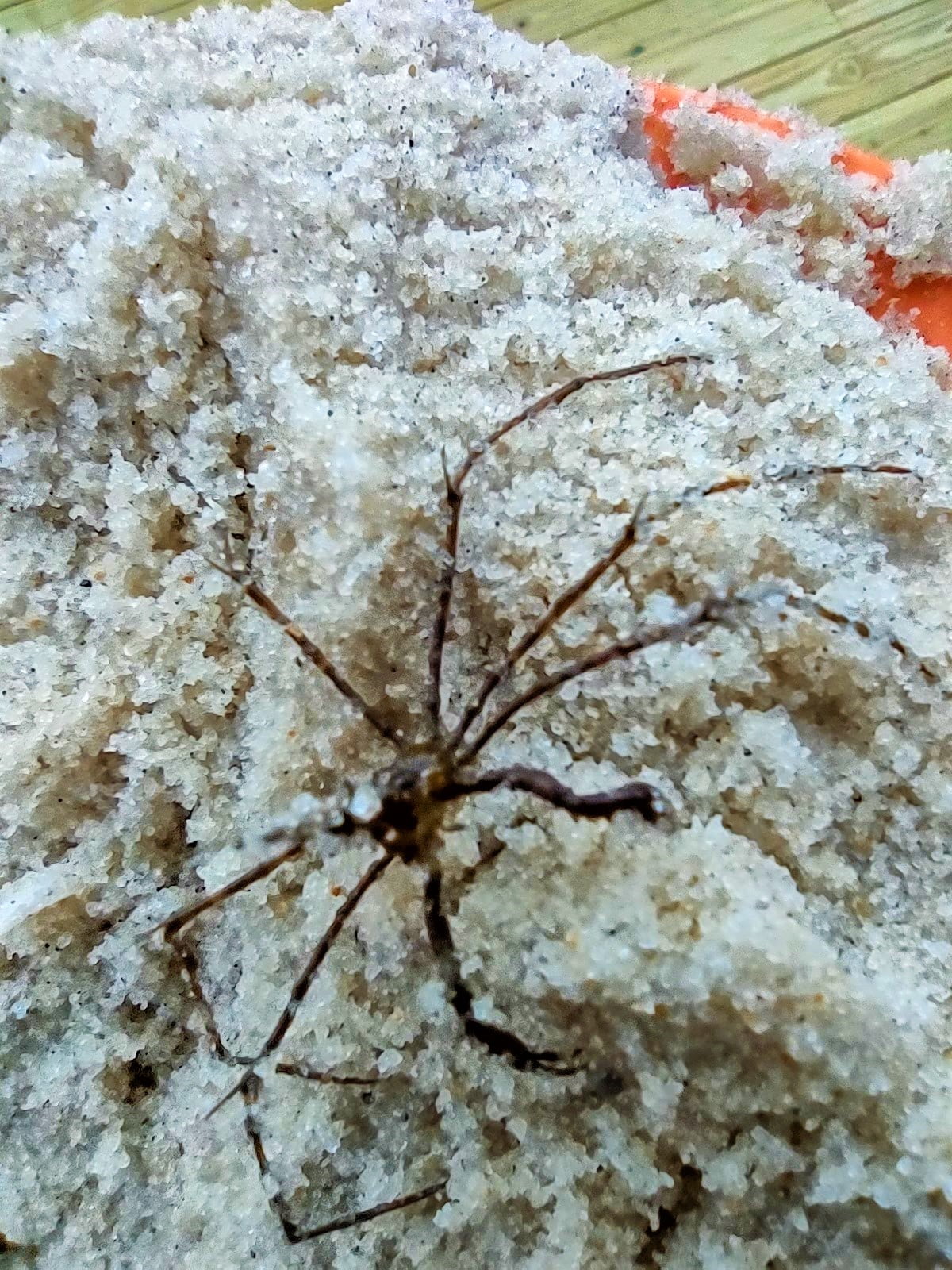
Yellowline Arrow Crab
Sent in by L.R., Sep. 17, 2021.
What a cool find; that is Stenorhynchus seticornis, a yellowline arrow crab, named for the pointed protrusion coming from its head. They are a nocturnal crab normally found hiding in underwater crevices and coral reefs at depths of 10 to 30 feet, so it is quite unusual you found one on the water's surface and during the day! It was likely displaced by the heavy storms we've been seeing here and out in the Gulf. Arrow crabs are the "cleaners" of their environment, consuming algae, bristle worms, and organic particulates that would otherwise impact growth of the coral reefs they live in. Interesting fact: Arrow crabs are docile around humans and readily allow handling by divers and aquarium keepers. However, they are extremely aggressive towards other crabs (even other arrow crabs) and will not hesitate to injure or kill a crab found within their territory.

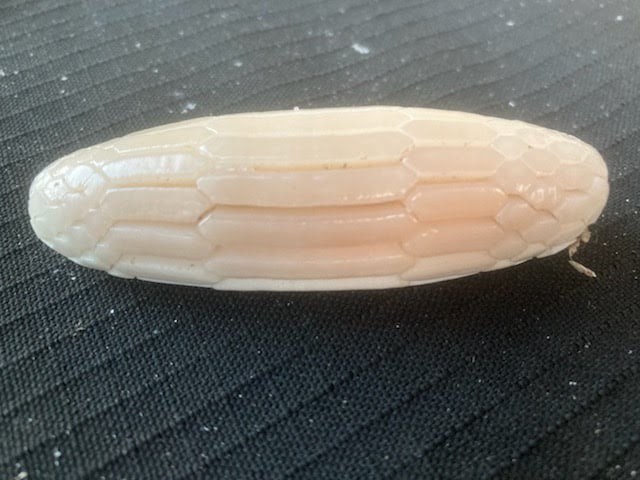
Cownose Ray Dental Plate
Sent in by Linda C, Oct. 25, 2021.
You have the top dental plate from Rhinoptera bonasus, a cownose ray. Cownose rays belong to the Eagle Ray family, along with the iconic giant manta and the devil ray. Adult cownoses have an average wingspan of 3 feet and can weigh up to 50 pounds. While they do have a venomous spine at the base of their tail, they are shy and generally swim at the surface and so pose a minimal risk to humans. Cownose rays, like humans, have two sets of dental plates, one along the upper jaw and one along the lower jaw. Their teeth are incredibly strong and uniquely shaped in a way that allows the ray to easily crush shells of mollusks and crustaceans, nutcracker-fashion.

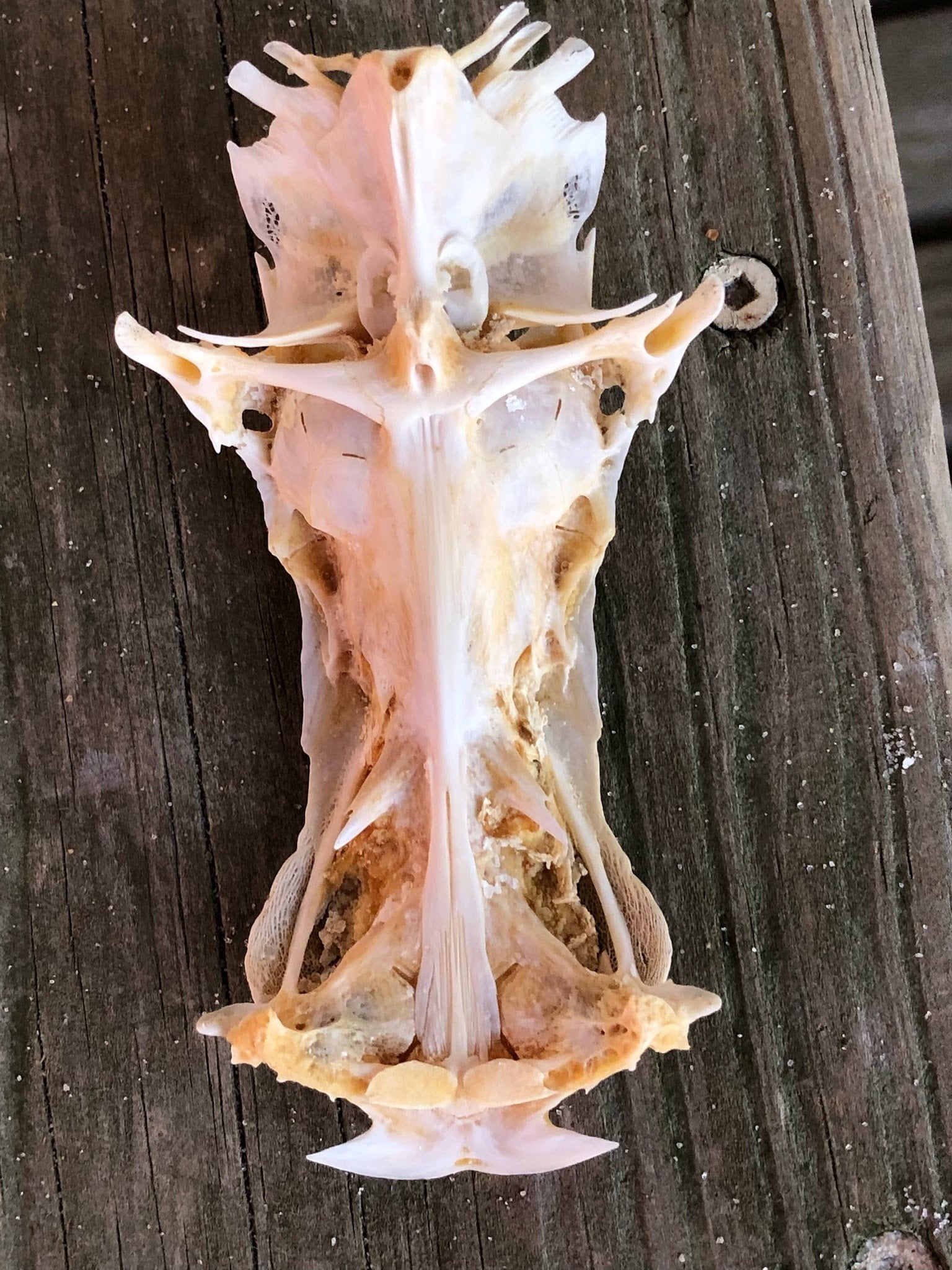
Hardhead Catfish Headplate
Sent in by Lori Triplett, Oct. 27, 2021.
What you have here is the head plate of a hardhead catfish (Ariopsis felis). Also known as "the crucifix bone," its unique shape makes it a popular beachcombing find. Across many Gulf coast towns there is story known as the "Legend of the Crucifix Fish," which explains that the lowly, unloved hardhead catfish was imprinted by God to demonstrate His love for all His creations, even for those disliked by others. The legend also has it if you shake the bone, you will hear dice being thrown, which is the sound of Romans gambling for Christ's garments (This is actually the sound of the hardhead catfish's otoliths, or ear stones, which help keep the fish in balance while swimming). Moreover, this bone is considered good luck to those who find it. Whether you believe in the legend or not, it is nonetheless a cool find!

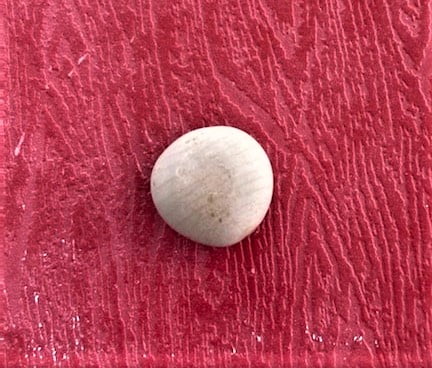
Gray Nickerbean
Sent in by Mike Perrini, Oct. 7, 2021.
What you have there is a Caesalpinia bonduc drift seed, also known as a gray nickerbean. Drift seeds are well adapted for oceanic travel; they are both extremely buoyant and highly durable. C. bonduc is a legume plant common to both the Caribbean and Florida Keys. It's journey to the Panhandle is quite fascinating: after maturing and detaching from a C. bonduc plant, it likely fell into a nearby river or floodplain where it was eventually taken out to sea. Once far enough out, it would have been picked up by the North Atlantic gyre and by this current brought into the Gulf. From there, it was likely pulled out of the gyre by a passing storm and deposited onto our beach. This journey might have only taken only a few days, or it could have taken months, depending on wind and ocean current conditions (many sea beans are able to spend years out to sea, but the gray nickerbean cannot sustain for more than a few months). Interesting fact: gray nickerbeans are one of many drift seeds that can be polished and kept on display, or even used to make jewelry. There's actually a growing market for sea bean jewelry in art/craft online marketplaces, such as Etsy.

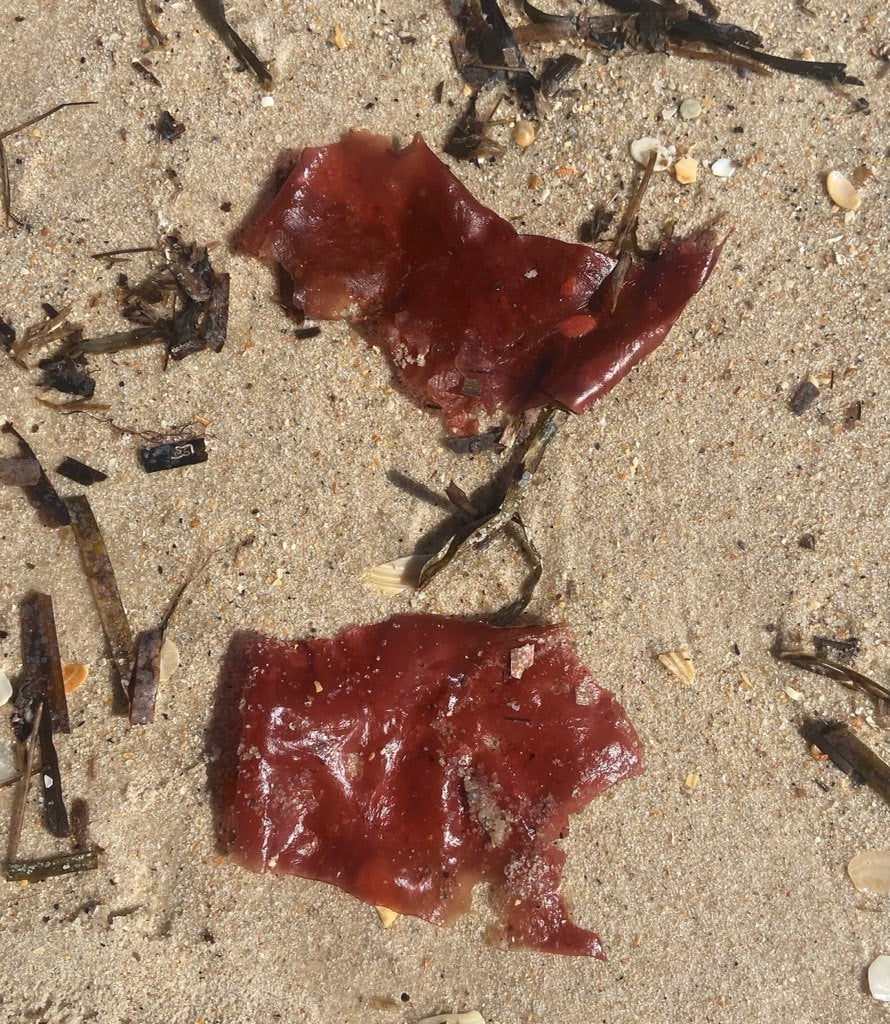
Red Macroalgae
Sent in by Mike Perrini, Oct. 8, 2021.
That appears to be a less-common red macroalgae (seaweed) known as Halymenia Floridana. H. Floridana is unrelated to red tide, which instead is single-handedly caused by microalgae known as Karenia brevis. Algae are an incredibly diverse group; you have some that look and act like bacteria (K. brevis), and others that are only a step away from being a plant (H. Floridana). H. Floridana grows offshore in deeper Gulf waters but can be uprooted and brought to the beach by heavy wave action produced by hurricanes or severe storms. What you see are its pseudo (fake) leaves; in its complete form it looks like a head of red lettuce.

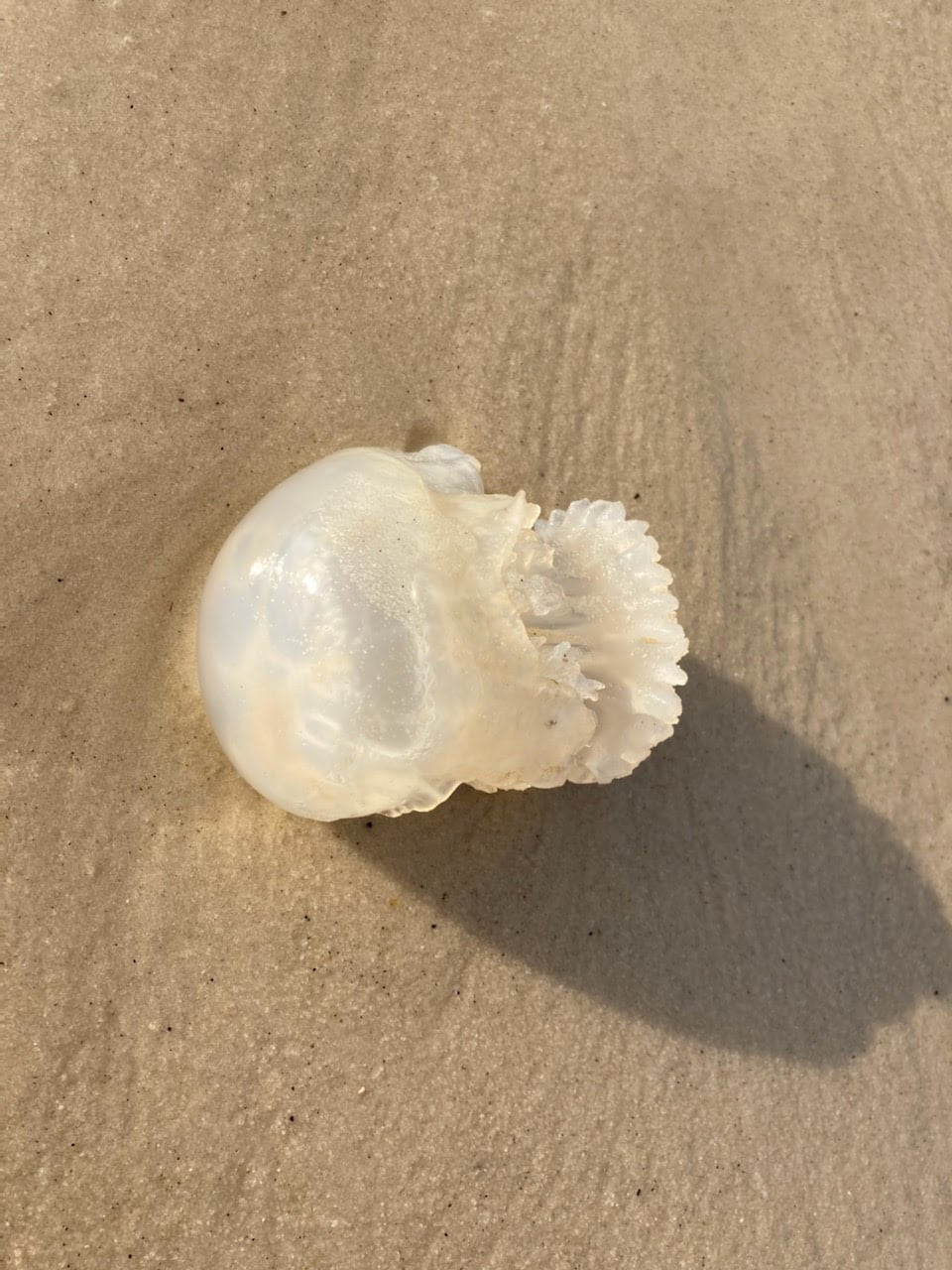
Cannonball Jelly
Sent in by Suzanne P, Oct. 22, 2021.
That is Stomolophus meleagris, a cannonball jelly. It must have been tossed around a good bit in the surf, as it has lost the bell that usually covers its top. They are more of a seasonal visitor, unlike the moon and comb jellies that are always found in our waters (and look like blobs of clear jello). Cannonball jellies do not have stinging cells strong enough to harm humans, but when stressed can produce a toxic mucus that causes cardiac issues upon ingestion. Interesting fact: cannonball jellies are a common food item in Asia, often dried (to get rid of the toxic mucus) and added to sea salads.

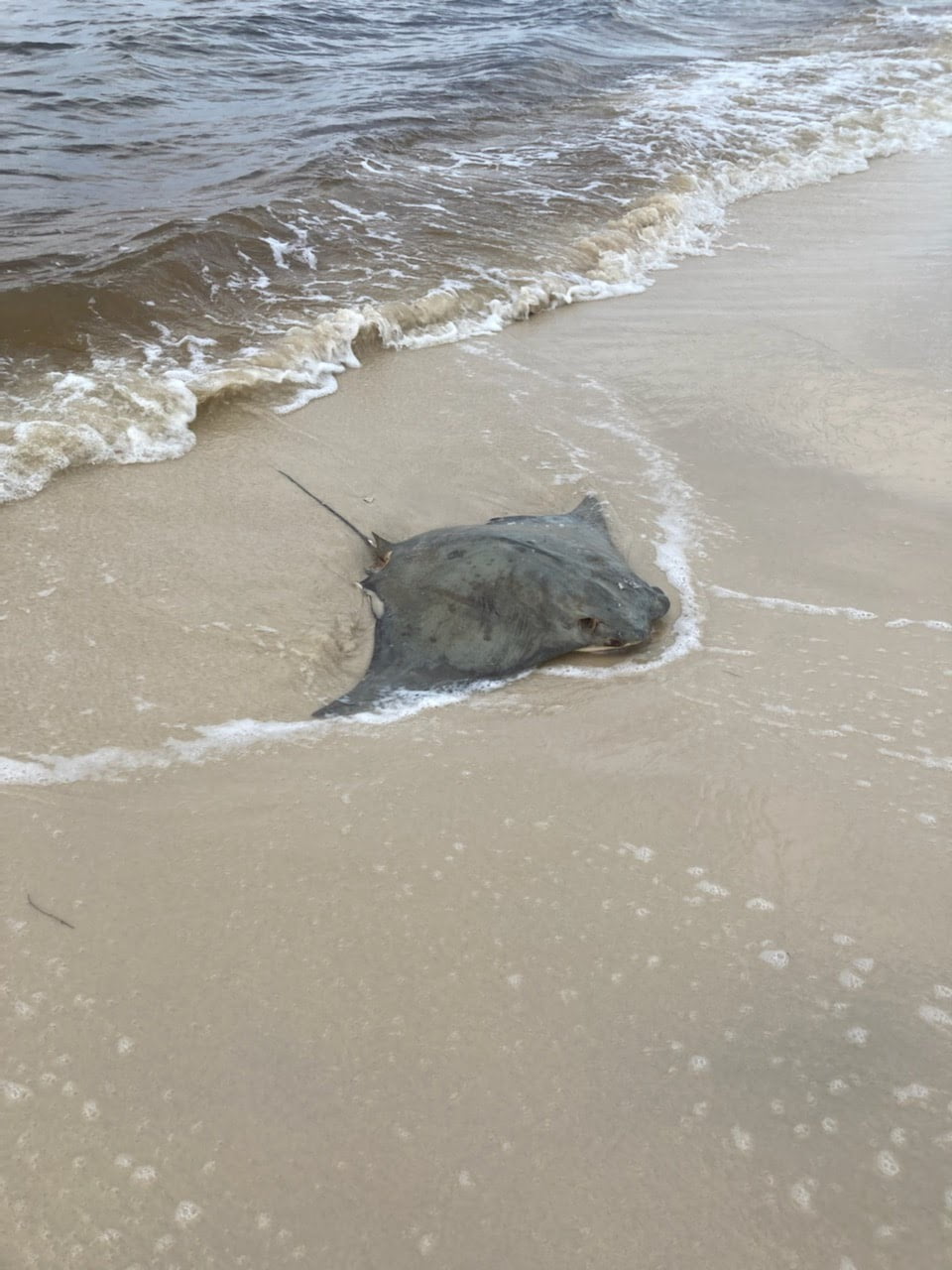
Cownose Ray
Sent in by Suzanne P, Oct. 14, 2021.
That is a juvenile cownose ray (Rhinoptera bonasus) that likely passed due to the red tide. Cownose rays belong to the eagle ray family, along with the iconic giant manta and the devil ray. Adults have an average wingspan of 3 feet and can weigh up to 50 pounds. The eyes are located near the very front of his snout. Above the eyes are its spiracles, which can appear as empty eye sockets at first glance! Really, they are the top gills of the ray, which are used to continue breathing while their main gills underneath are covered in sand as they burrow into or rest on the seafloor. While they do have a venomous spine at the base of their tail, they (like most rays) are a shy, docile species. Interesting fact: during his 1608 voyage, Captain John Smith was accidentally stung by a cownose after catching it on his fishing line. He nearly died from the sting, and the beach it all happened at has been known as Stingray Point ever since.

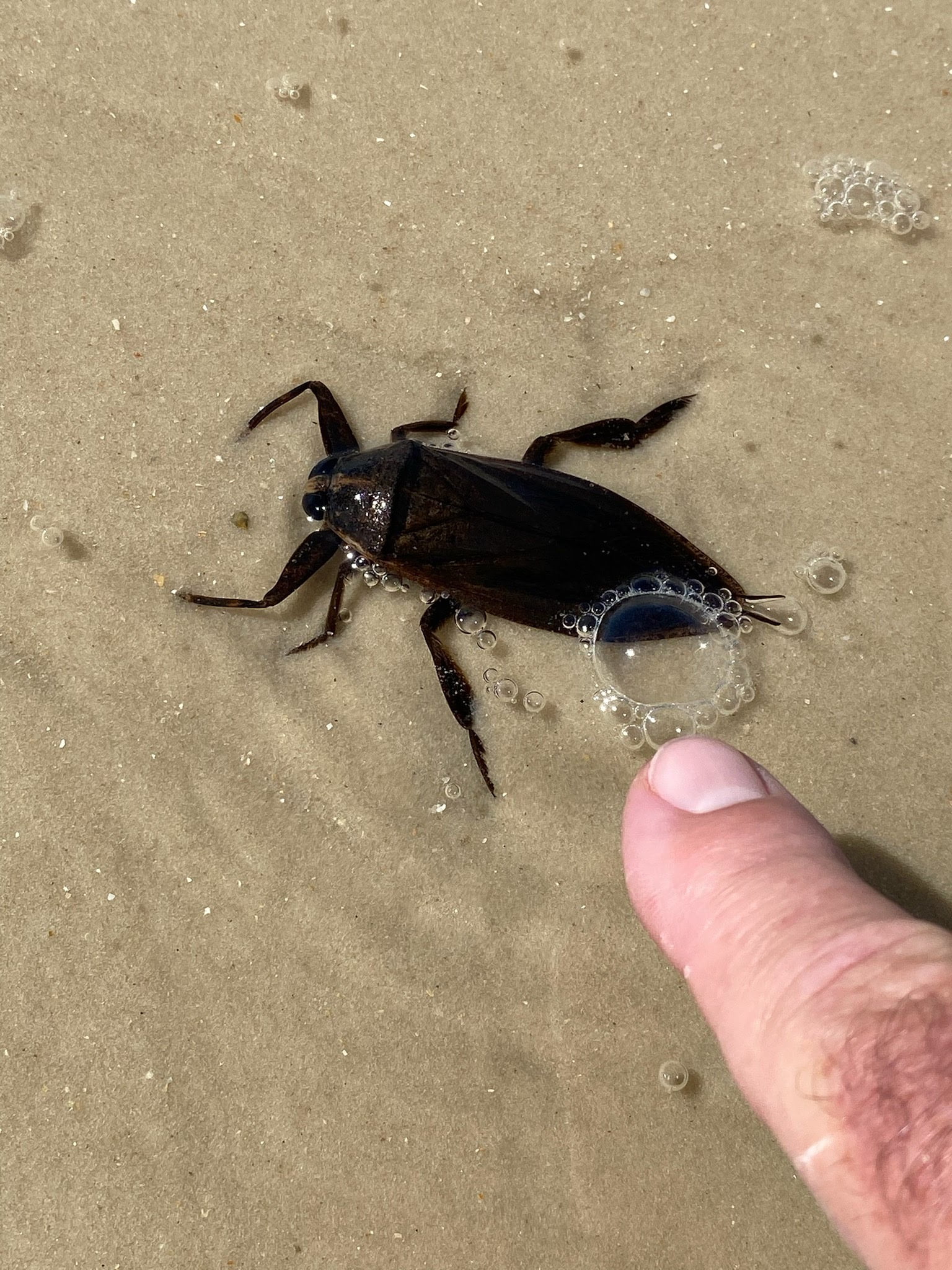
Giant Water Bug
Sent in by Z. Tobin, Oct. 15, 2021.
That is Benacus griseus, a species of giant water bug. Informally, it is known as an eastern toe-biter, as they can pack quite a painful bite when provoked. The strange thing is, this bug absolutely does not belong at the beach. They are strictly a freshwater species, meaning he must have either floated into the Gulf with water hyacinth from the river, or he was flying around, looking for a new freshwater home, when he got lost/exhausted and made a pit stop at the beach!

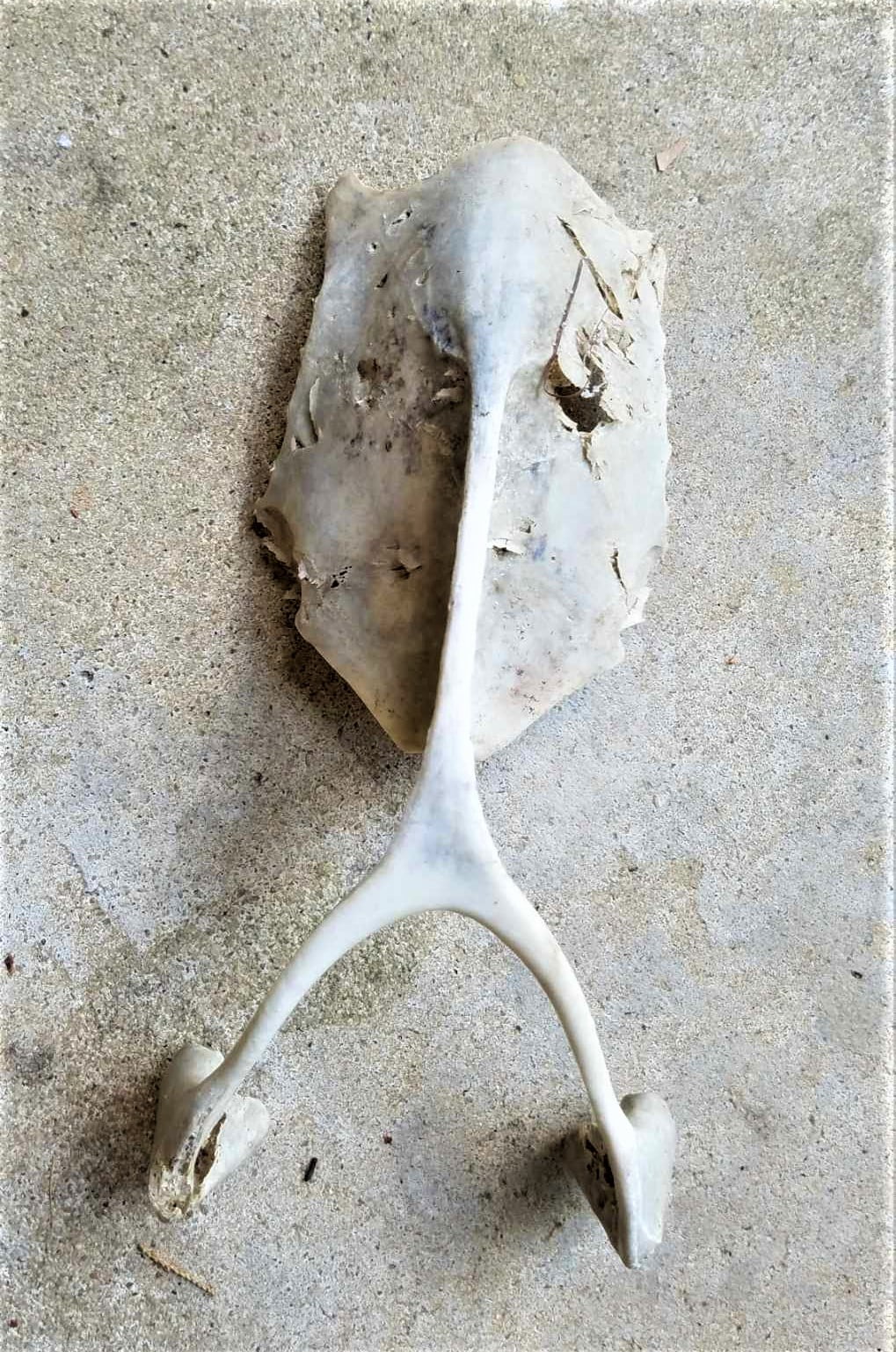
Pelican Sternum and Furcula
Sent in by R.K., Dec. 30, 2021.
This is the sternum and furcula (clavicle) of a large water-bird, most likely a white or gray pelican, given the triangular shape of the sternal crest. You might know the furcula by its common name, the wishbone! Interesting fact: not all bird species have a furcula. But for those that do, it holds a key role in strengthening the thorax (chest) for the repetitive flapping motion that comes with flight.

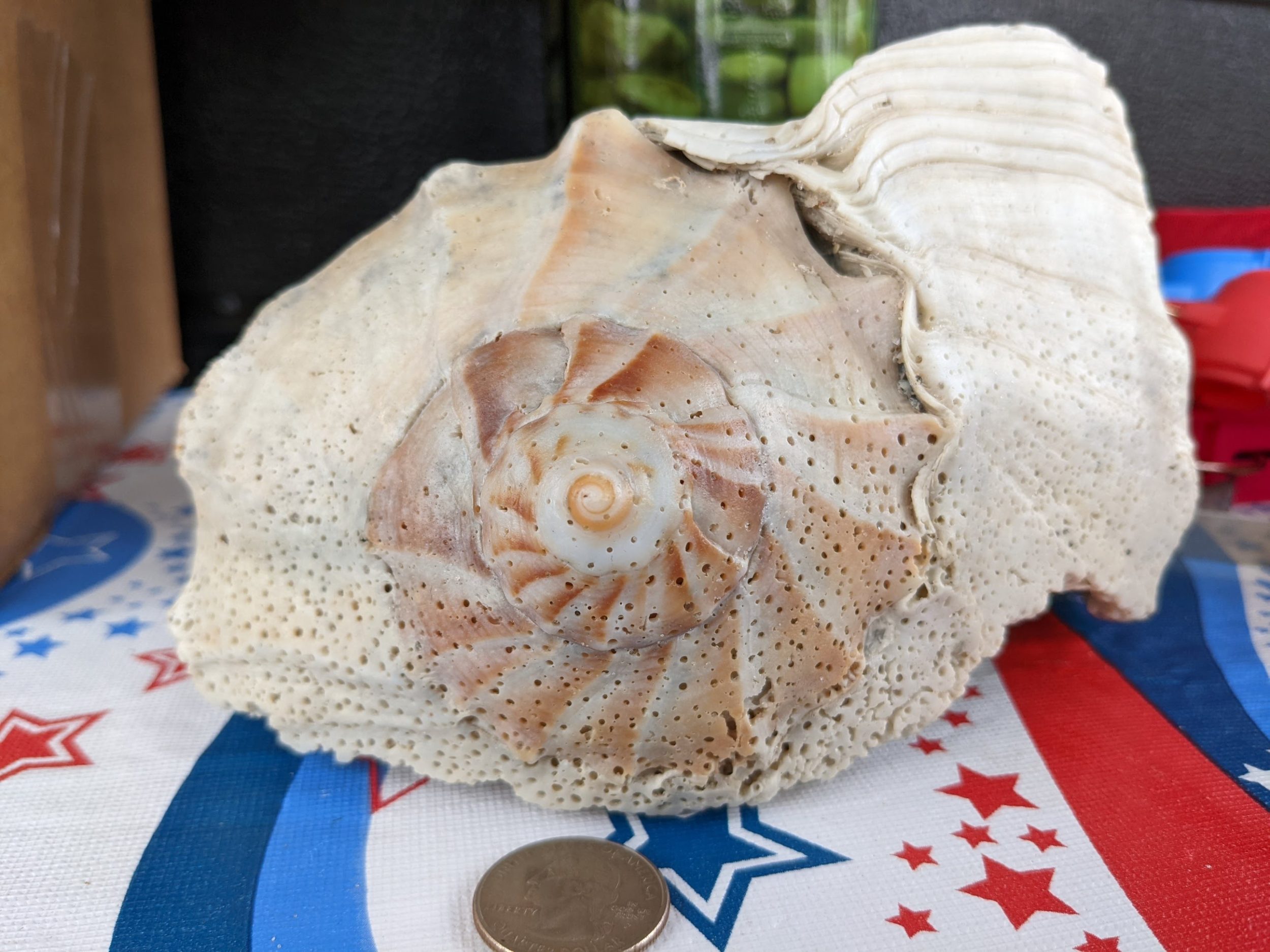
Lightning Whelk Shell with Boring Sponge Damage
Sent in by Rachel TerBeek., Jan. 10, 2022.
This appears to be a broken-up lightning whelk shell (Busycon sinistrum) that has begun to deteriorate. The small holes you see are perforations from a boring sponge, meaning this shell was likely half-buried in the shallow seafloor for some time and used as substrate for the sponge to anchor to. A boring sponge does this by using its digestive acids to wear away at the shell's composition so that it can effectively take root. Interesting fact about lightning whelks: they are unusual in that they spiral counterclockwise, otherwise known as being left-handed. For most other marine snails, being left-handed is a rare abnormality that results in sterility. Being a "lefty" holds its advantages for lightning whelks though. For instance, they are more likely to survive predation attempts by stone crabs, who's crusher claw is always on the right side.

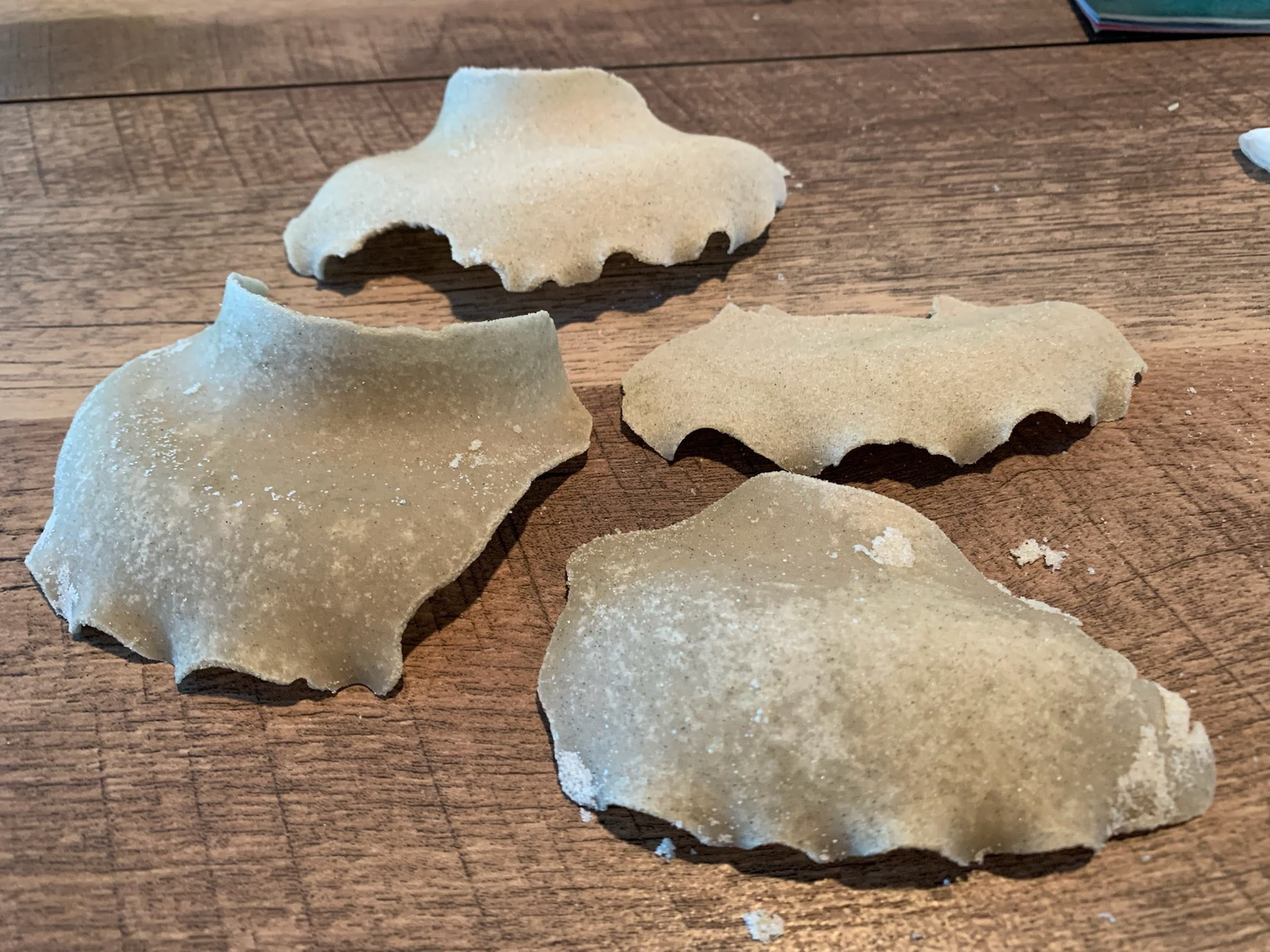
Moon Snail Egg Casings
Sent in by R. Porucznik, Jan. 17, 2022.
These are portions of sand collars made by moon snails, likely the shark-eye moon snail (Neverita duplicata) given our location in Florida. Sand collars are actually the moon snail's egg casing. When she's ready, a female snail will travel to the surf zone in order to spin her eggs. The eggs are mixed with a gelatinous mucous that when added to wet sand, cements into a "collar." The collar is meant to provide the eggs some protection while they continue to develop. One sand collar can hold approximately half a million microscopic snail eggs. Since you found multiple pieces rather than a whole collar, the eggs have likely already hatched from these. Interesting fact about moon snails: when you find a seashell on the beach with a perfectly-round hole drilled into it, that means the creature in that shell was preyed upon by a moon snail. They use their radula to scrape away at the shell and eat the bivalve inside.

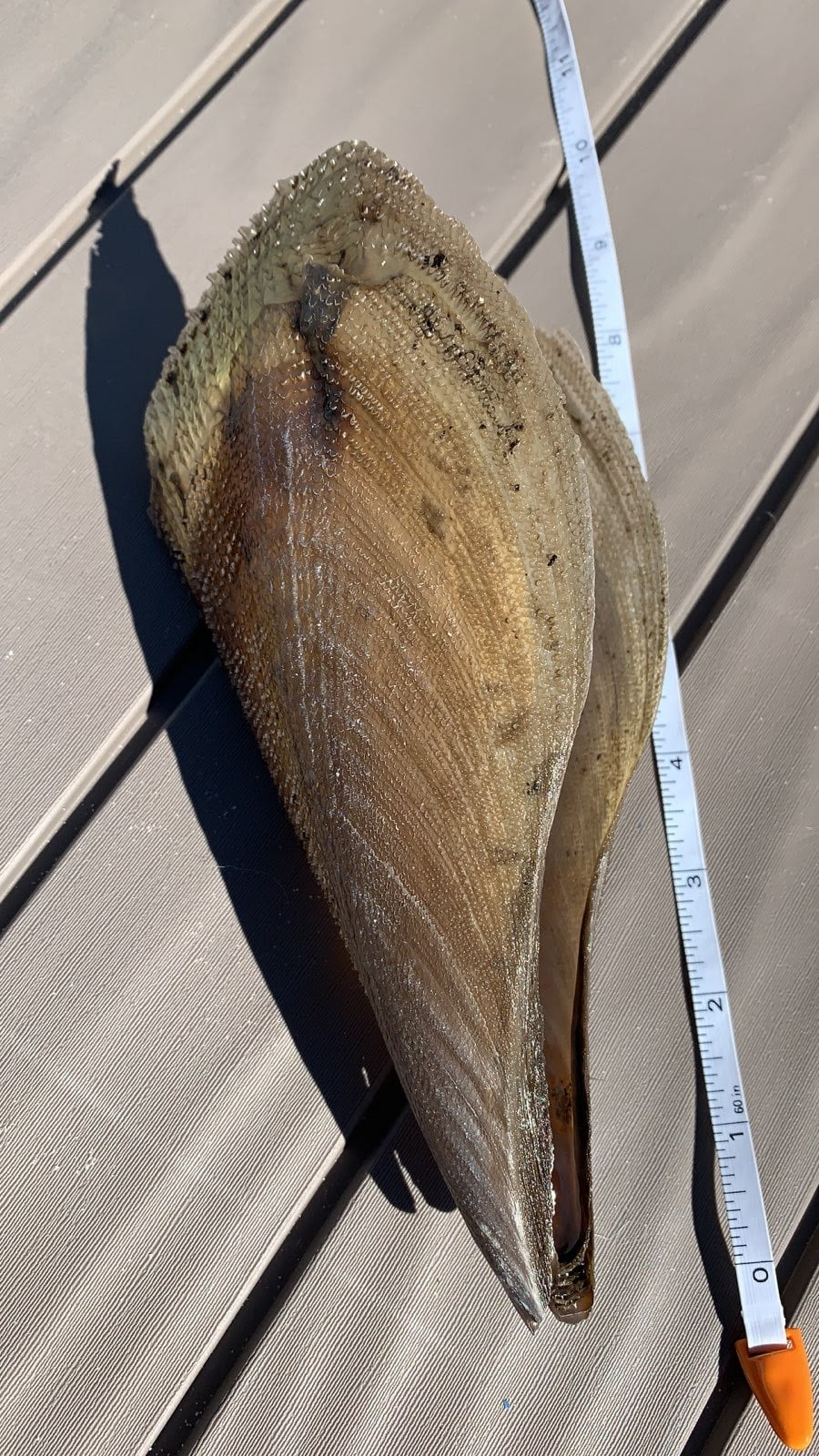
Sawtooth Penshell
Sent in by R. Porucznik, Jan. 30, 2022.
What you have here is Atrina serrata, a sawtooth penshell. Penshells are filter-feeding bivalves that anchor to rubbly sand using their byssal threads. In Florida, they are common in shallow waters near seagrass beds and are usually found buried in the sand with only the upper portion of the shell exposed. They are one of the largest bivalves in the world, reaching a max of 10 inches long. The one you found isn't far off from their maximum size! Interesting fact: Penshells are often hosts to pen shrimp or pea crabs. Both creatures will occupy the penshell while its alive and feed on whatever the penshell filters from the water. While this relationship is of parasitic nature, these organisms do not seem to cause penshell mortality.

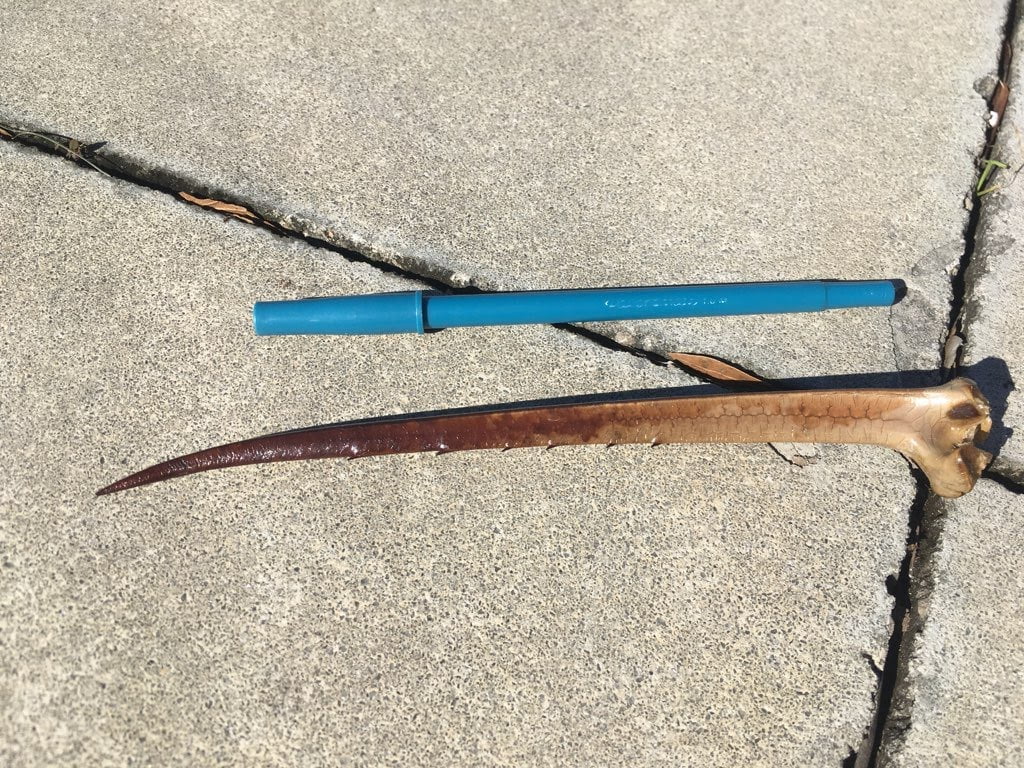
Horsehoe Crab Telson
Sent in by Diane Foster, Jan. 12, 2022.
This is a horseshoe crab’s tail spine, otherwise known as its telson. They use the telson to help steer through the water and also to flip themselves back over if they have ended up on their back! It likely broke off of a horseshoe crab molt before you found it. Horseshoe crabs are arthropods, meaning they have an exoskeleton made of something called chitin. The exoskeleton functions as both the skeletal structure and the "skin" of arthropods. At the beginning of their lives, horseshoe crabs are no larger than the palm of your hand. In order to grow, they have to shed their current exoskeleton and replace it with a larger one. This is the process of molting, which they must do at least once a year for the rest of their lives. All species of crabs do this, as do lobsters and many types of insects. Fun fact about horseshoe crabs: they are considered 'living fossils,' as their species has existed for at least 445 million years. In other words, they were in the ocean while dinosaurs roamed the planet, and even before dinosaurs existed!

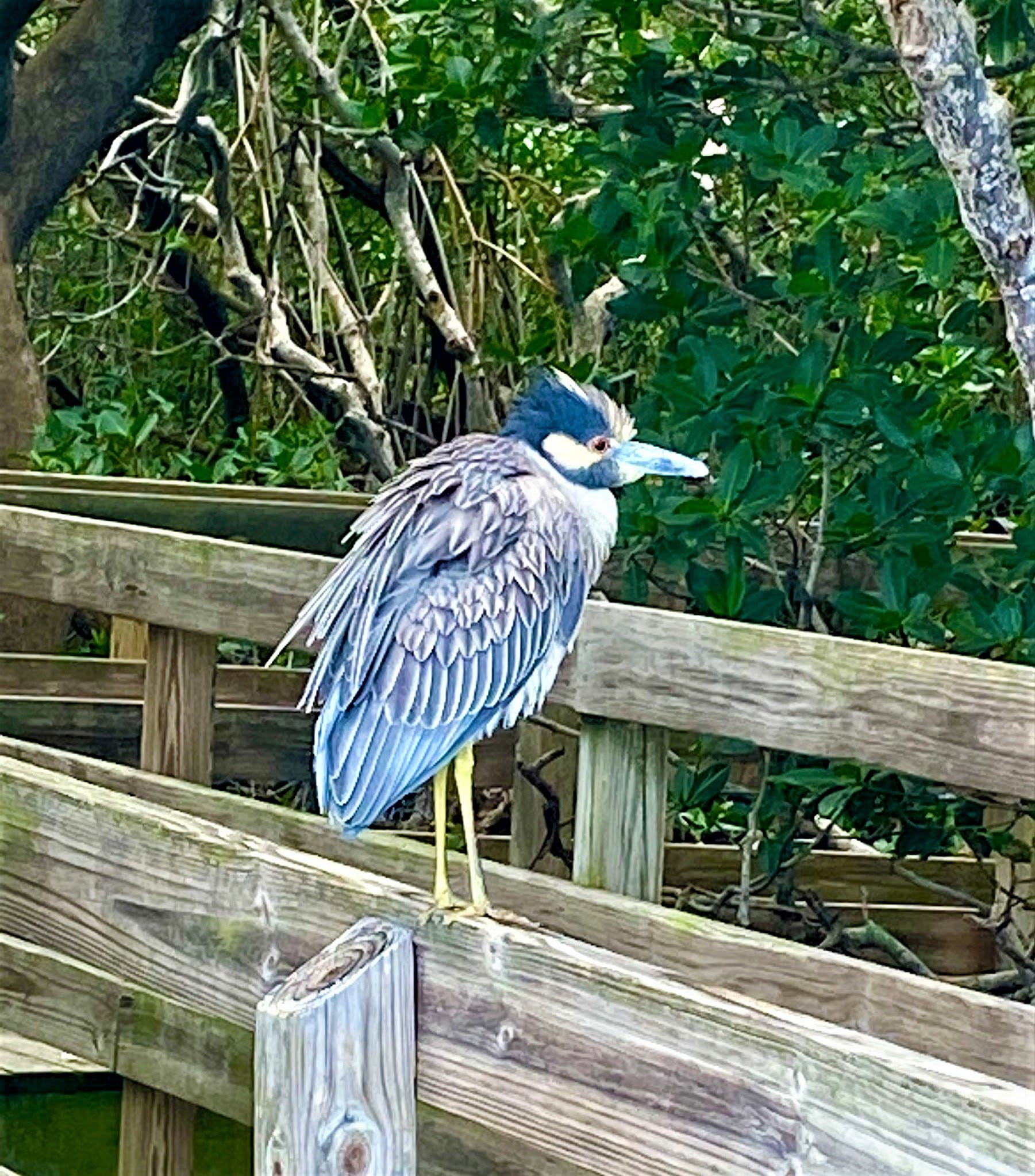
Adult Yellow-Crowned Night Heron
Sent in by CJ, Feb. 2, 2022.
This is an adult yellow-crowned night heron (Nyctanassa violacea). They are a stockier variation of heron, but nonetheless exhibit the same “elegance” in carefully stalking through shallow wetlands. Yellow-crowned night heron prey on crabs and crawfish and will only nest in areas that host a large population of either species. Yellow-crowned night herons are a close relative of black-crowned night herons. Adults of each species are easy to distinguish between; yellow-crowned have a boldly-marked face that black-crowned lack. Though juveniles can be easily confused. Interesting fact: yellow-crowned night herons were exterminated from the island of Bermuda by early settlers. Their absence allowed local land crab populations to skyrocket out of control. The yellow-crowned night heron was successfully reintroduced to Bermuda in 1976. Crab populations declined back to normal levels, demonstrating the important ecological role of night heron.

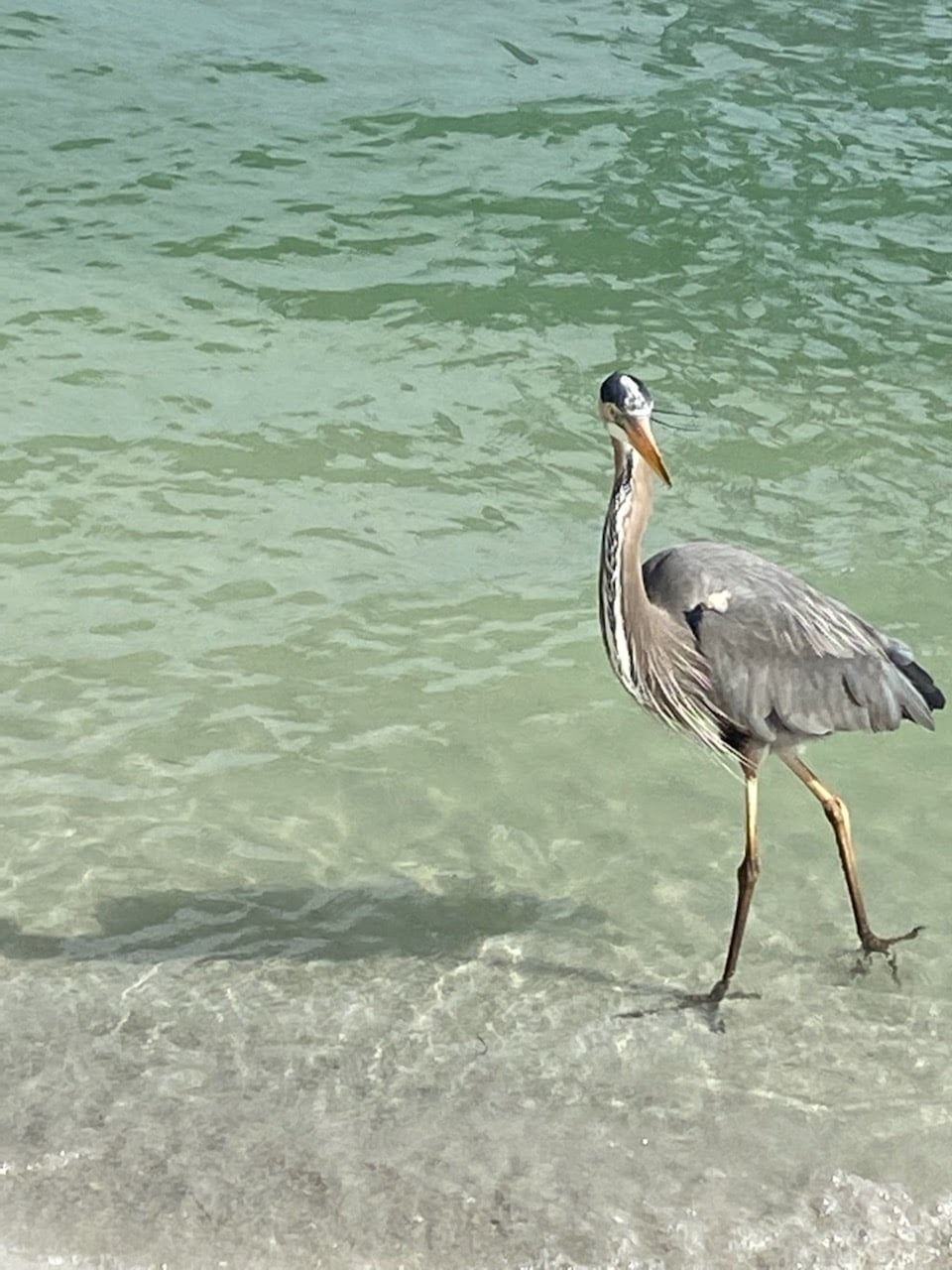
Great Blue Heron
Sent in by CJ, Jan. 30, 2022.
This bird is an adult great blue heron (Ardea herodias). It is a wading bird common to Florida that can be found near both fresh and salt water. In marine environments, they slowly stalk the swash zone in search of shrimp and small fish, just as the one pictured here is doing. When they find suitable prey, they strike with lightning fast speed. Its patience in this type of hunting is quite admirable! Interesting fact: there is a subspecies of great blue heron that exists only in southern Florida and the Keys. It is known as the great white heron (Ardea herodias occidentalis). It was first thought the great white heron was only a color morph of the great blue, but recent evidence shows that it is in fact its own subspecies.

